How Do You Improve Staff Wellbeing in School?

Staff wellbeing is a key issue in any workplace, but it’s acutely felt in schools. With one in three teachers considering leaving the profession, protecting staff wellbeing is essential to ensuring the longevity of teachers’ careers.
Looking after staff is, of course, one of a great many tasks school leaders have to juggle, so we’ve done the homework to provide you with some ideas to improve staff wellbeing.
Support Each Other
Your fellow staff members will naturally feel stressed when faced with high workload, high expectations, overlapping responsibilities and accountability – all common pressures to school staff. So they need to know that their leaders and colleagues have their backs.
Ensuring mutual support means creating a culture and a community where staff feel able to ask for support when they’re feeling stressed. Nothing heightens stress more than feeling like you have to deal with it alone, so how can you make sure staff know they’re supported?
The ‘work family’ metaphor is a feature of many workplaces and for good reason – if people feel connected, it makes it easier to deal with difficult situations. Consider how can you foster that culture and become a champion for your colleagues.
Be Proactive
Unfortunately, high workloads and expectations seem ingrained in the current education system. It’s tough for school staff to deal with expectations from the DfE, governors, parents… It’s a lot and we can’t pretend otherwise.
But by acknowledging these difficulties, we can at least be proactive in addressing them. Don’t wait for issues like high workload and burnout to become problems. Consider what you can do now to minimise their negative effects.
In her previous role as a headteacher, our Schools Consultant Lorna gave staff the option to take PPA time at home, which is a great way to help staff manage their work-life balance and show that you trust them to do it properly, too.
When you review school policies, considering any changes in terms of staff workload is a proactive way to ensure you’re taking your staff’s needs into account. For example, you could consider introducing something like Parent Time to help you schedule parent-teacher meetings, giving staff the opportunity to schedule meetings around family commitments.
Regularly getting staff feedback on how they’re feeling can help you gauge what changes you can make to provide more support.
Minimise Admin
Based on teachers’ responses to a Teacher Tapp survey, administrative tasks regularly make more than 40% of teachers feel stressed or unhappy, second only to student behaviour. Unfortunately, we can’t take away everyone’s marking, but there are ways to reduce other administrative tasks using technology.
For example, Studybugs Attendance can automate absence reporting, freeing up 30 days of staff time every year. We can also automatically alert staff about attendance concerns, so staff don’t have to spend time analysing data and can instead be notified automatically, allowing them to focus more on the pastoral side of their role – which is obviously more rewarding.
Support the Right to Switch Off
Ensure staff feel like they can have time to themselves. Little touches like providing fresh fruit in the staffroom and avoiding meetings outside school hours can help staff feel valued.
You could also implement initiatives like sending no emails outside of school hours (or make it clear that staff don’t have to reply), and do what you can to ensure teachers minimise the amount of marking they take home – like providing uninterrupted PPA time.
Remember to Look After Yourself
Of course, you’ll need to be in a good place yourself to think about how you can support others. Remember to cut yourself some slack, build in time for yourself and practice self-care. And if you develop a nurturing culture in your school, your colleagues will have your back, too.
Hopefully, these ideas will get you excited about the prospect of fostering a culture of good staff wellbeing in school. Just writing this blog post has got me feeling very zen. Namaste!
— Lucas Abbott
Counting Days of Absence (Attendance and Sickness Returns)
Please sign in with your local authority staff account to see this blog post.
Don’t have a staff account?
If your organisation is registered with Studybugs (or you’re not sure), please
New Parent Alerts for Counting Register Marks
Please sign in with your school, trust or local authority staff account to see this blog post.
Don’t have a staff account?
If your organisation is registered with Studybugs (or you’re not sure), please
A New Way To Work With Your Attendance Data
Please sign in with your local authority staff account to see this blog post.
Don’t have a staff account?
If your organisation is registered with Studybugs (or you’re not sure), please
How to Improve Attendance in UK Secondary Schools

In a secondary school, improving attendance isn’t just about tracking absences – it’s about making attendance a whole-school priority. With the right tools, schools can make attendance everyone’s business, turning data into action, reducing barriers for students, and creating a positive, inclusive environment that students want to be part of.
So stick with us while we outline some strategies to improve attendance in UK secondary schools.
Take a Whole School Approach
Improving attendance in a secondary school means making attendance everyone’s business. It’s not just the remit of your attendance officers; from SLT to form tutors, everyone has an important role in securing good attendance.
Setting a framework for your approach to attendance is a great way to ensure staff feel confident fulfilling their roles in securing good attendance. This would include your intervention plan, role descriptions and escalations so that everyone is clear about how you intend to improve attendance as a school. It’s also a great thing to show Ofsted, as they’ll want to see your attendance strategy – particularly how you work to reduce persistent absence.
If you’d like help planning your whole-school approach or want to run it by an attendance expert, book a free consultation with one of our friendly schools consultants.
Build Strong Relationships With Families
Secondary schools that promote good attendance tend to have clear messages about their expectations and communicate these expectations directly and plainly with students and parents. However, you’ll struggle to engage with students and their families if you don’t have good relationships with them.
The foundations for good communication with families are trust and honesty. It’s important to build a positive relationship with families and establish trust so that when you need to have difficult conversations around subjects like persistent absence, they’re more likely to accept what you have to say.
Analyse Attendance Data in Detail
An important part of any attendance strategy is to analyse attendance in detail. Where are there patterns of absence? Which students need support? What interventions are working?
Your attendance system should help you easily monitor data at school, year, form, cohort and pupil level, helping you analyse attendance across target groups. This is exactly what Studybugs Attendance does.
From persistent absence to poor punctuality, analysing your data effectively means you can intervene early and prevent problems from escalating. Which brings us to our next point.
Act on Your Data Effectively
Having the right data available is no good if you don’t use it.
Using your data is key to planning and carrying out the right interventions. When you spot an area of concern, dig deeper to find the underlying reason for absence. For example, if a pupil is frequently absent on a certain day, is there a lesson they’re nervous about attending?
Understanding your data and using it to plan your actions is key to making improvements like reducing persistent absence or improving punctuality.
Studybugs can help you with this by automatically notifying the right staff about attendance concerns, so they can act immediately on the data, eg sending your SENCo a notification when a student with SEND is absent without reason so they can follow up.
Remove Barriers to Attendance
Addressing the underlying reasons for absence is key to improving attendance and reducing persistent absence. That’s no secret, but identifying these obstacles can take some effort.
Schools using Studybugs Attendance can dig deeper into their attendance data, helping them identify barriers so that they can focus their efforts there, saving time and effort and ultimately helping them intervene earlier.
But improving attendance doesn’t end there. Successfully reintegrating students after a period of absence is also critical. Students or their families can feel anxious about returning to school for fear of being told off for their absence. Of course, following an absence or pattern of absences, the last thing you want is for a student to be worried about coming back in.
We heard about a school that created a safe space for students to arrive at school, so students can arrive after an absence or habitual poor punctuality without worrying about being told off the moment they step through the door.
Create an awesome school culture
Securing good attendance doesn’t happen in isolation. It’s related to the quality of your school’s curriculum, ethos, behaviour and inclusivity.
In other words, make school a place students want to be. Think about what you can do to improve pupil wellbeing. And, for that matter, staff wellbeing.
Maybe that’s revamping your breakfast club with a new menu or board games on the tables. Maybe you make it a goal to have the school with the happiest staff. Did you see the viral post about the school that placed pianos all around their site for children to play at break times? What a great idea that was!
Whatever you decide to do, have some fun creating an awesome culture for your school.
Give Students a Sense of Purpose
Part of creating an awesome school culture is about giving students a reason to want to be in school. Giving students a sense of purpose is a great way to improve engagement with school by helping students feel empowered and responsible.
That could be getting them involved in the school play, encouraging them to take part in school sport or starting a new lunchtime club. When students feel engaged and accountable to others, it gives them a tangible reason to come to school.
See How Studybugs Can Help You Improve Attendance
At Studybugs, our goal is to keep children happy, healthy and in school. With bespoke tools that help you act early on attendance data, plus the ongoing support of a dedicated schools consultant, we’re working with secondary schools up and down the country to help them manage attendance more effectively. We’d love to help you too.
— Lucas Abbott
How to Improve Attendance in UK Primary Schools
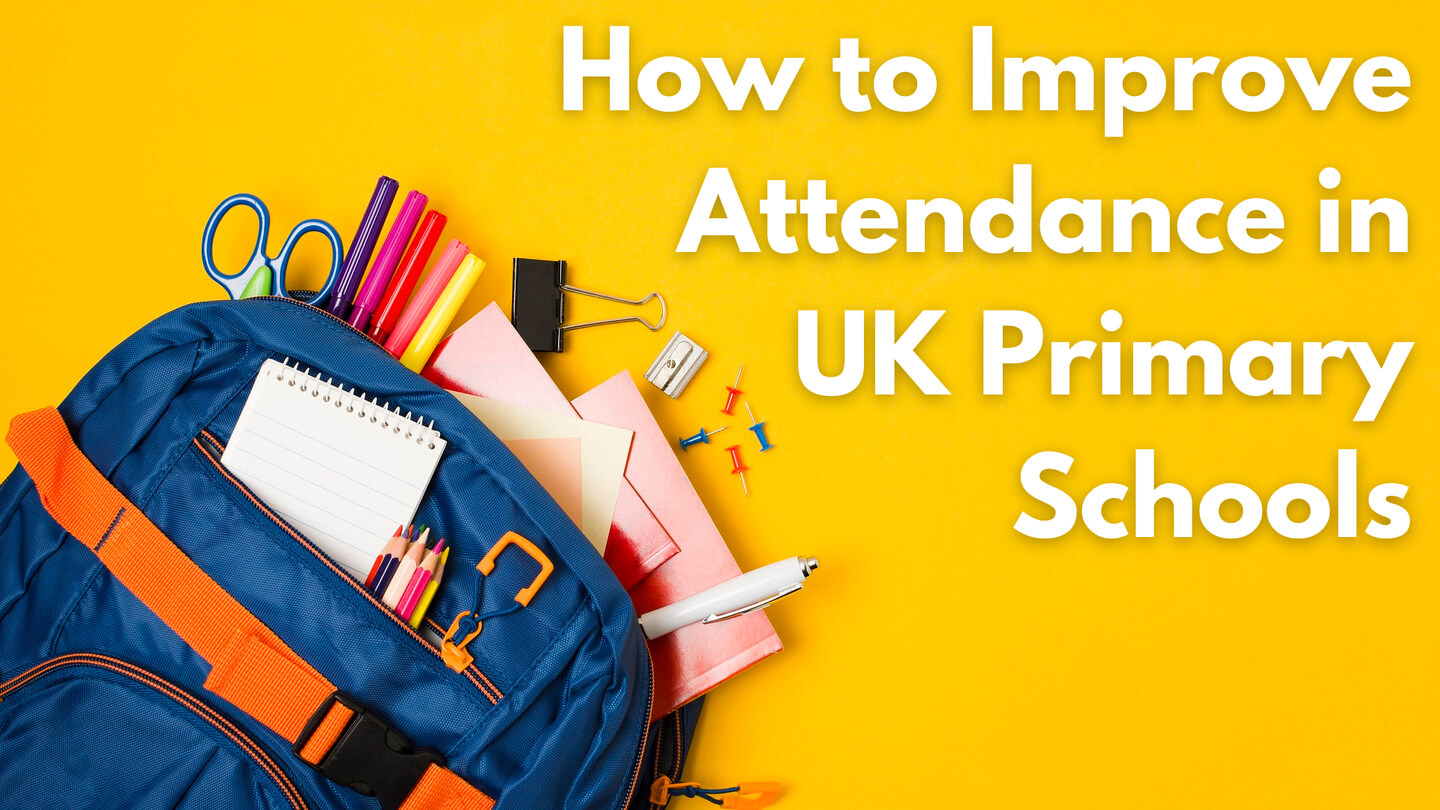
Improving attendance in a primary school takes a collective effort. When everyone in the school community understands their role in promoting attendance, the impact can be transformational.
In this blog post, we’ll explore some approaches you can build into your attendance strategy to help you keep children happy, healthy and in school.
Take a Whole School Approach
Improving attendance in a primary school means making attendance everyone’s business. From SLT to admin staff, teachers and teaching partners, everyone has an active role to play in encouraging good attendance and supporting families.
For classroom staff, that might be a pastoral role based on your relationship with the children you work with. For admin staff and SLT, it might also include analysing attendance data and working with families.
What’s clear is that it’s important everyone understands their role in improving attendance and feels supported in their role. This might mean discussing your attendance strategy with all staff during an INSET day. Your attendance strategy will outline your approach to managing attendance, including your intervention plan, role descriptions and escalations.
It’s also a great thing to show Ofsted, as they’ll want to see your attendance strategy – particularly how you improve the attendance of persistent absentees.
If you’d like help planning your whole-school approach or want to run it by an attendance expert, book a free consultation with one of our friendly schools consultants.
Build Strong Relationships With Families
Keeping parents engaged in their children’s school life is critical for them to understand the importance of school and why it’s necessary to attend as much as possible.
It’s vital to build a positive relationship with families and establish trust so that when you need to have difficult conversations around subjects like persistent absence, they’re more likely to accept what you have to say.
Analyse Attendance Data in Detail
An important part of any attendance strategy is to analyse attendance in detail. Where are there patterns of absence? Which children need support? What interventions are working?
Your attendance system should help you easily monitor data at school, year, class, cohort and pupil level, helping you analyse attendance across target groups. This is exactly what Studybugs Attendance does.
From persistent absence to poor punctuality, analysing your data effectively means you can intervene early and prevent problems from escalating. Which brings us to our next point.
Act on Your Data Effectively
Having the right data available is no good if you don’t use it.
Using your data is key to planning and carrying out the right interventions. When you spot an area of concern, dig deeper to find the underlying reason for absence. For example, if a pupil is frequently late, is there a problem with transport to school?
Understanding your data and using it to plan your actions is key to making improvements like reducing persistent absence or improving punctuality.
Studybugs can help you with this by automatically notifying the right staff about attendance concerns, so they can act immediately on the data, eg sending your SENCo a notification when a child with SEND is absent without reason so they can follow up.
Remove Barriers to Attendance
Addressing the underlying reasons for absence is key to improving attendance and reducing persistent absence. That’s no secret, but identifying these obstacles can take some effort.
Schools using Studybugs Attendance can dig deeper into their attendance data, helping them identify barriers so that they can focus their efforts there, saving time and effort and ultimately helping them intervene earlier.
But improving attendance doesn’t end there. Successfully reintegrating children after a period of absence is also critical. Children or their families can feel anxious about returning to school for fear of being told off for their absence. Of course, following an absence or pattern of absences, the last thing you want is for a child to be worried about coming back in.
We heard about a school that created a safe space for students to arrive at school, so families can drop off children without fear of having a confrontational conversation the minute they reach the school gates.
Create an awesome school culture
Securing good attendance doesn’t happen in isolation. It’s related to the quality of your school’s curriculum, ethos, behaviour and inclusivity.
In other words, make school a place children want to be. Think about what you can do to improve pupil wellbeing. And, for that matter, staff wellbeing.
Maybe that’s revamping your breakfast club with a new menu or board games on the tables. Maybe you make it a goal to have the school with the happiest staff. Did you see the viral post about the school that placed pianos around their site for children to play at break times? What a great idea that was!
Whatever you decide to do, have some fun creating an awesome culture for your school.
See How Studybugs Can Help You Improve Attendance
At Studybugs, our goal is to keep children happy, healthy and in school. With bespoke tools that help you act early on attendance data and save time on admin, plus the ongoing support of a dedicated schools consultant, we’re working with primary schools up and down the country to help them manage attendance more effectively. We’d love to help you too.
— Lucas Abbott
Supporting Children Who Miss School Due to Mental Health
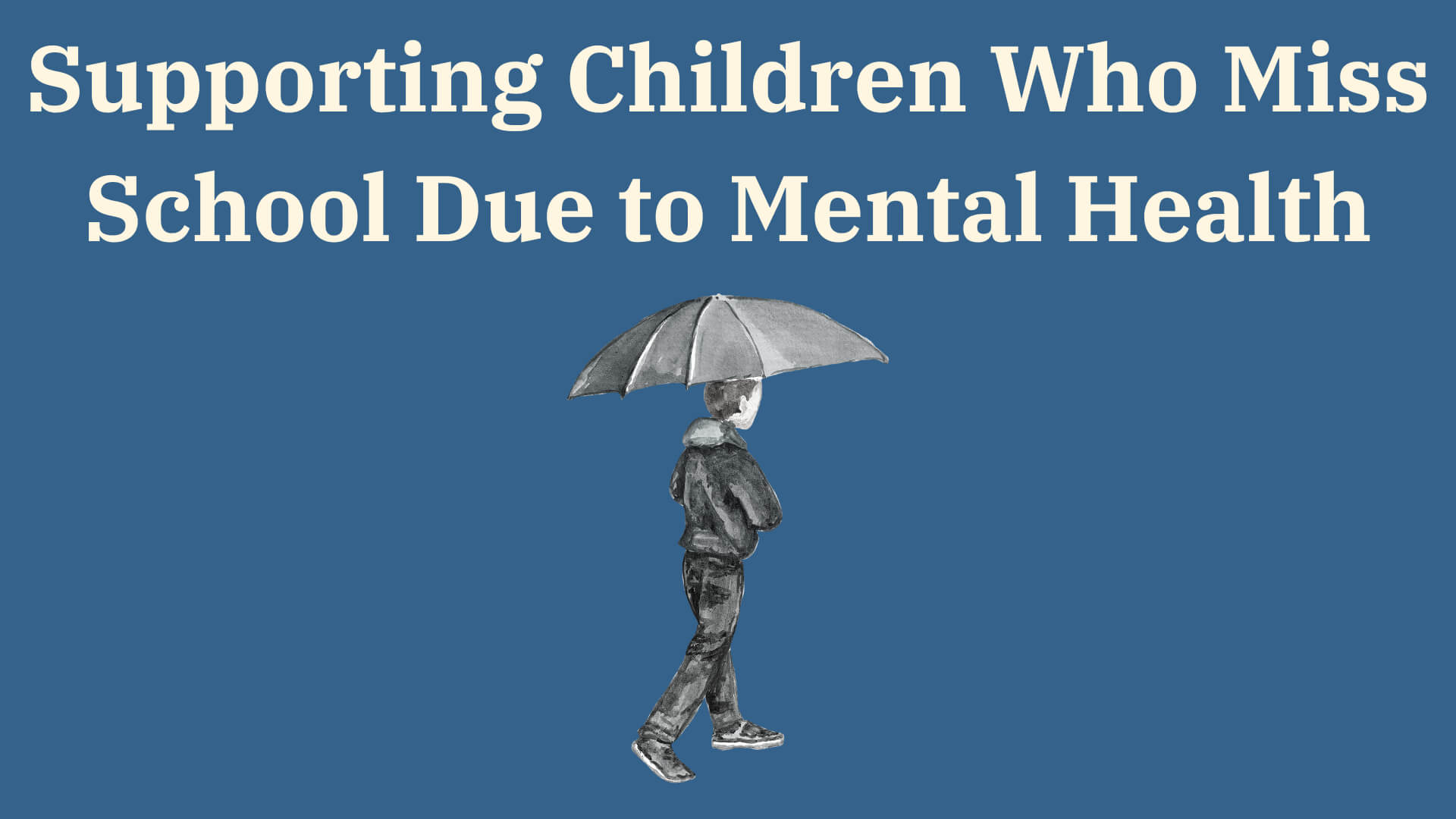
We all know the benefits of keeping children in school. So when mental health issues become a barrier to attendance, it’s vital to support children to ensure they feel able to attend school consistently. By working together with families, and engaging partners like local authorities and healthcare providers where necessary, schools can empower children to overcome challenges and thrive academically and personally.
In this blog post, we explore how to take a structured, compassionate approach to supporting pupils who miss school due to mental health issues.
So without further ado, here are five creative ways to improve school attendance.
Create an Inclusive Environment
To start, let’s take a look at what you can do to support children’s mental health in school generally. That comes down to creating a supportive and inclusive school environment.
A supportive and inclusive school environment fosters better outcomes for students facing mental health challenges. Schools should train staff on mental health awareness and implement whole-school approaches that reduce stigma and promote emotional wellbeing.
Of course, even in the best environment, there are going to be children who miss school for mental health-related reasons.
So what can you do when that happens?
Identify Issues and Intervene Early
Schools play a pivotal role in spotting early signs of mental health struggles. After all, children spend a lot of time in school and have a lot of significant relationships there.
School staff can take a two-pronged approach to identifying pupil absences where mental health is a factor. The first is, of course, in a pastoral capacity. Staff who work closely with children will be some of the best-placed people to spot any changes in behaviour. Pupils may be withdrawn, start acting out, or become disengaged with school.
The second prong is checking the attendance data. If a child who was attending well suddenly has gaps in their attendance, it could indicate a deeper issue. Look for patterns in their absences. Do they struggle to come back to school after weekends or holidays? Do they miss a certain lesson regularly? Whether there’s an obvious pattern or not, if you think something’s wrong, it’s time to talk to them.
Establish and Maintain Communication with Families
Parents and families are critical partners in supporting children with mental health-related attendance issues. They need to actively participate in monitoring their child’s progress and provide emotional support, and their input will have a huge impact on the success of any support plans (see below for more on this).
As such, they need to be supported in their role. Fostering an open, collaborative relationship between schools and parents is key to ensuring they can support their children in attending school.
Parents may also need their own support. They might find it hard to talk about their difficulties getting their child to school. Or the child’s attendance issues could be triggered by something home-related like a divorce or separation. As a school, you can help by keeping in regular contact with parents and agreeing how and when you’ll keep in touch.
Devise Tailored Support Plans
Schools are advised to create tailored support plans for children whose attendance is affected by mental health. These plans should reflect the child’s unique needs, providing them with the support they need to feel comfortable attending school.
The plan should be agreed with the parents or guardians and the pupil, and staff who come into contact with the pupil need to be aware of it. If necessary, you might want to offer adjustments such as flexible timetables, modified workloads, or a phased return to school.
Also, remember that progress is not likely to be in a straight line. You might have a good week followed by a bad one. Keep on top of how your plan is working, and make a note of progress and any setbacks so you know if you need to make any changes.
You should also involve the child and their parents or guardians in any review. It’s a good opportunity for you all to celebrate successes and talk through things you’re finding difficult. Hopefully, the review process will be positive for everyone as you see progress being made.
Engage External Support When Necessary
Of course, school staff are not expected to diagnose mental health conditions or know exactly how to deal with every situation. Where external help is needed, you might want to discuss plans with your local authority, as they can help coordinate with healthcare providers such as Child and Adolescent Mental Health Services (CAMHS) to ensure support for your pupil.
Families are also encouraged to seek professional help when needed and engage with school-recommended services. These services might be included in your support plan, so effective support will often rely on collaboration between schools, families, local authorities and healthcare providers.
Compassion is Key
Lastly, just remember that children are likely to respond best when they feel supported. The more you can do to show them you’re on their side, the better.
I hope you find the guidance above useful. For further help, you can find the DfE’s full guidance on your responsibilities here.
— Lucas Abbott
Monitor Attendance of Children at Out-of-Area Schools
Please sign in with your local authority staff account to see this blog post.
Don’t have a staff account?
If your organisation is registered with Studybugs (or you’re not sure), please
5 Creative Ways to Improve School Attendance
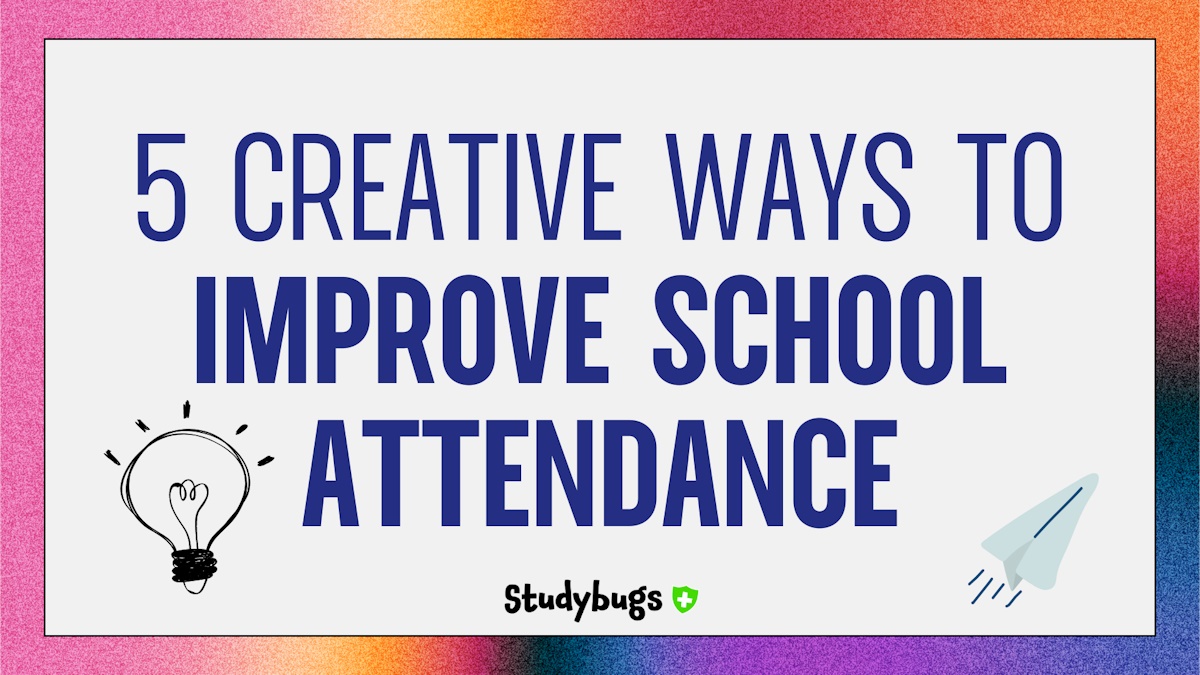
Improving school attendance is no easy feat. And with school attendance yet to fully recover since Covid, schools are understandably looking for new and creative ways to improve attendance.
If that’s why you’re here, you’ve come to the right place. These innovative approaches to improving attendance will take you beyond the obvious solutions, helping you to think about motivating pupils, building strong relationships and understanding how attendance fits into your wider school culture.
So without further ado, here are five creative ways to improve school attendance.
Create an Awesome School Culture
Good attendance doesn’t happen in isolation. It’s related to the quality of your school’s curriculum, ethos, behaviour and inclusivity. Building an awesome school culture is a great way to encourage and reward good attendance.
For example, we’ve heard about a school that noticed they had lower attendance on Fridays. So they started serving pancakes and waffles at their breakfast club to increase Friday attendance. This school also put core subjects on Fridays so pupils knew it was as important to attend on Friday as any other day.
Help Pupils Find Meaningful Involvement
Many successful schools emphasise the connection between attendance, academic success, and future opportunities. To take this to the next level, try coupling this with a more immediate purpose for pupils to attend.
Maybe that’s being in charge of stage lights for the school play, joining the netball team, or starting a video games club at lunchtime. Giving pupils responsibility helps them feel empowered and accountable to others. They’ll be engaged and encouraged to attend school when they feel like they have a purpose.
Build Strong Relationships
Schools that successfully secure good attendance understand that attendance is everyone’s responsibility, not just that of your attendance officer or deputy head. Ensuring staff understand their roles means they can build positive relationships with pupils.
Pupils also report that having a consistent person they feel they can talk to makes a huge difference. Whether that’s a class teacher, a teaching partner, school nurse, if pupils have a strong relationship with a staff member, that staff member can broach difficult subjects with them like attendance.
The same goes with parents. It’s important to establish trust with parents so that when you have to have difficult conversations, they’re more likely to accept what you have to say.
For example, school leaders could build relationships with pupils by greeting them at the start of each day. Having a positive interaction with pupils (and not being someone who just admonishes them about uniform or being late) helps build that relationship.
One final relationship to foster is between pupils themselves. You could introduce a mentor programme where older pupils support younger pupils, or a peer-to-peer system where pupils feel accountable to each other. These relationships have many benefits, helping older pupils feel responsible and younger children supported, again giving them a reason to come to school.
Gamification
Gamification is the concept of adding game mechanics into nongame situations. This could be something like attendance awards or an attendance “streak” of consecutive days.
These ideas are already in place in many schools, but need to be taken with a grain of salt as they can carry negative connotations – such as children feeling additional pressure and anxiety to achieve 100% attendance.
A more creative way to use rewards in your attendance strategy is to make them adaptable. Think about them on a case-by-case basis, using rewards for persistent absentees who make improvements or positive reinforcement for pupils returning from a part-time timetable.
Minimise Obstacles
Addressing the underlying reasons for absence is key to improving attendance.
That’s no secret, but identifying these obstacles can take some effort.
Part of that comes down to effectively analysing attendance data. Do pupils miss certain days regularly? Is a particular subject causing them anxiety? Mock exams? Using tools like Studybugs Attendance can help you identify patterns of absence, helping you intervene early.
One key thing to think about is whether you can pre-empt these issues. Could you put on a special breakfast club for exam-year pupils on days when they have mocks? Bring in a therapy dog? Have a post-exam pizza party? Plan a staff-student cricket match?
Involving pupils in these decisions is a great way to find out what would motivate them to attend and help them feel comfortable.
Of course, some obstacles to attendance aren’t as obvious. Reasons like bullying or embarrassment about clothes may not have clear patterns, but that’s why it’s so important to build trust and empathy, as outlined above.
Bonus: Free Posters!
Here’s one final idea for how to improve attendance creatively: get creative with your existing practices and resources.
For example, many schools put up displays to encourage good attendance. But these are often covered in graphs or are very text-heavy, making them difficult for pupils and parents to engage with at a glance.
So we created some fun, creative posters that demonstrate the impact of school absence in terms pupils will respond to. Check them out here.
Time to Get Creative
Improving attendance in today’s environment requires creative thinking and planning.
You may need to experiment, be willing to try something and adapt. But by concentrating on your school’s culture and pupil wellbeing, you can make school a place children genuinely want to be.
So there you have it – five creative ways to improve attendance (plus a bonus). Enjoy getting creative!
— Lucas Abbott
Introducing More Cohorts and Reports for Local Authorities
Please sign in with your local authority staff account to see this blog post.
Don’t have a staff account?
If your organisation is registered with Studybugs (or you’re not sure), please
How to Prevent Parent Fines for School Absence
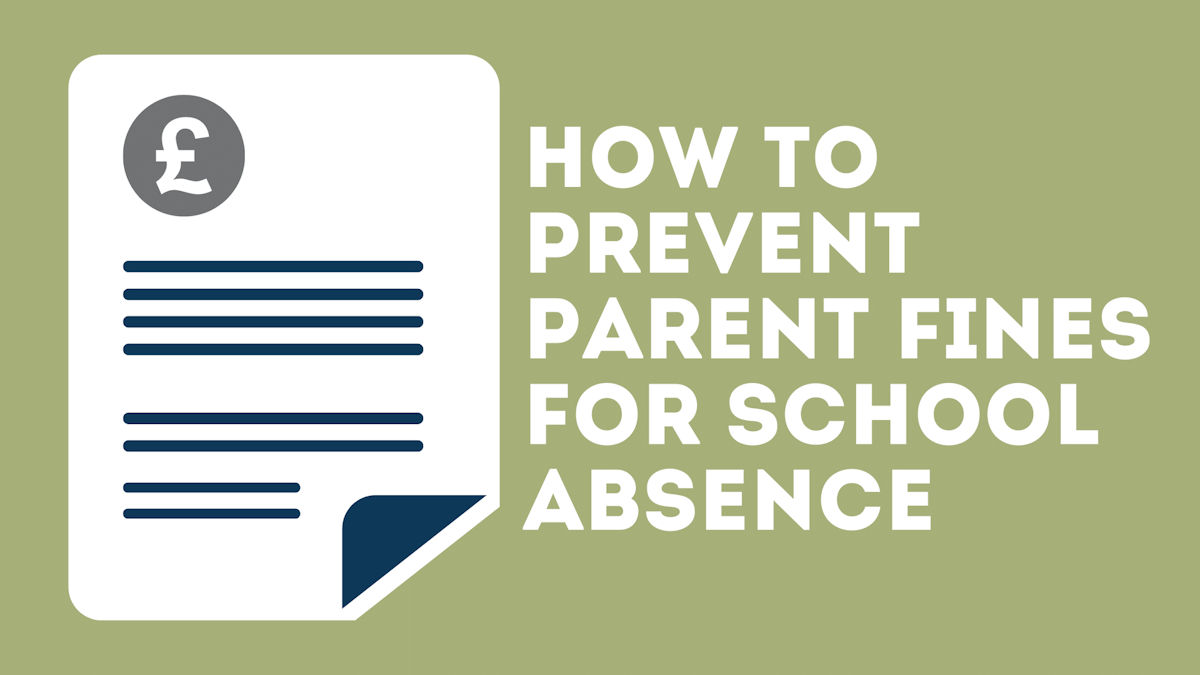
Penalty notices for school absence are increasing from £60 per parent to £80. But for school leaders, fines are generally the absolute last resort. There are a number of avenues of support, both formal and informal, that schools can explore to prevent the need for a fine. Let’s take a look at what they are and when a penalty notice is appropriate.
What Are Penalty Notices For?
Penalty notices are intended to improve attendance and prevent the need for court action. Ultimately, their purpose is to change parental behaviour, so they should only be issued when this is possible and other avenues of support have not worked.
Of course, there are circumstances where support would not have been appropriate and schools may go straight to issuing a fine – most notably term time holidays.
What Triggers a Penalty Notice?
Schools can consider issuing a fine when a child reaches the national threshold – currently 10 sessions of unauthorised absence in a rolling period of 10 school weeks. This could be 10 consecutive sessions of absence, 1 session a week for 10 weeks… basically any combination of unauthorised absence.
Fines should always be the last resort though. Schools are encouraged to consider what support might be appropriate and whether or not a penalty notice is the best tool to improve attendance.
What Can You Do To Prevent Penalty Notices?
School absence is often an indicator of wider issues, so schools should get to the root of why a pupil is missing school. Meeting with the family, setting informal goals, having one-to-one conversations with the child and rewarding attendance are among the options schools can try here. There’s also support available from external agencies if appropriate.
When your options for support have been exhausted, there are other types of legal intervention you can turn to before penalty notices.
Different Forms of Legal Intervention
Attendance Contract
This is a formal agreement between parents and the school or local authority to address attendance issues. It’s not legally binding, but creates a more formal route to securing engagement with a family. The idea is to get all parties to work together, outlining their expectations and discussing what sort of support should be employed.
Education Supervision Order (ESO)
When voluntary options have been exhausted, schools and local authorities can turn to ESOs, a legal intervention without prosecution, made through a Family or High Court. These formalise a set of requirements parents must follow in order to ensure their child receives the full-time education they’re entitled to.
Notice to Improve
This is the final opportunity for parents to engage with support you’re offering. You outline the child’s attendance history, the conditions of improvement (eg no further unauthorised absences), a clear timeframe for this improvement (that must be between 3 and 6 weeks), and what happens if the conditions aren’t met.
Acting Early is Key to Preventing Problems
Obviously, no school wants to have to issue fines for school absence. That’s one reason why it’s so important for staff to act early when a pupil’s attendance is irregular.
We’ve recently introduced automated staff alerts that help you do exactly that. So you can get notified about a pupil’s absences within a timeframe of your choice – for example, 6 sessions in 6 weeks – giving you a chance to intervene before it escalates.
Combine these alerts with a regular schedule of whole-school alerts and you’ll be able to monitor patterns of absence and act early to provide support where necessary.
— Lucas Abbott
How to Save Loads of Time Managing Daily Attendance

Whether it’s your Office Manager or Attendance Officer, managing daily attendance likely takes up hours of someone’s time every single day. Recording absences, chasing absences, following up on missing marks and incomplete registers… Dealing with it all eats away at the time you want to spend doing other things – like using your attendance data to target improvements, or providing that personal touch with families who really need the support.
Here’s how you can save time on those daily tasks and free up time for work that makes a bigger impact.
Save Time Recording Absences
Recording absence with Studybugs couldn’t be easier. Parents send absence reports securely via the app or website; it comes through to your online portal for you to record and mark in the register. And if you have Studybugs Attendance, the whole process is automatic, saving you even more time.
This slick process means that an average of 84% of absence reports are received and processed before 9am, saving you vast amounts of time and letting you get on with your day.
Some schools are understandably hesitant to take away the personal aspect of speaking to parents and verifying absences over the phone. But we’re not suggesting you spend any less time personally speaking to parents. You can just shift that time away from the run-of-the-mill illness absences to families who really need the personal support – the child struggling with anxiety, the family with transport issues, or those with additional needs – so you can make a bigger impact.
As for verifying absence reports, Studybugs has a robust process: we match parents’ details with the information in your MIS, meaning 100% of absence reporters are verified. If there’s any doubt, we immediately alert you to take a look.
Automatically Chase Unexplained Absences
Schools using Studybugs can have up to 100% fewer unexplained absences to chase, thanks to our streamlined absence reporting process. We can also speed up the process of actually chasing them – through automated parent alerts.
Studybugs provides a variety of alerts for parents to keep them in the loop about their children’s attendance. This includes automated absence chasers. Simply create your message template, specify when it should send, and it’ll send to any children with ‘N’ marks in the register each morning.
Quickly Address Incomplete Registers and Missing Marks
Making sure every child is accounted for is obviously a vital safeguarding duty. So when registers are incomplete, it’s critical to follow up quickly. Studybugs helps you do this in three ways:
- Staff can receive alerts to notify them of missing marks in today’s registers.
- Admin staff can filter the attendance dashboard to show missing marks.
- For Primary schools using Studybugs Registers, teachers will also see a warning if their register hasn’t been completed.
All this means you can quickly find missing marks and follow up to ascertain a pupil’s whereabouts. It also means you don’t end up with a huge list of missing marks to correct ahead of census day or an inspection (although if you do need to find historical missing marks, you can use Studybugs Assistant). See our previous blog post for more on handling missing marks.
30 Days of Staff Time Freed Up Each Year
All these time-saving features add up to a whopping 30 days of extra staff time every year (based on a 300 pupil school). That’s a whole extra half a term you can put to better use.
“Studybugs has completely streamlined the way we manage attendance at our school. We are
able to more efficiently, quickly and collaboratively manage attendance in the mornings, and SLT are able to keep
a closer eye on strategic attendance issues.”
– Russell Kinch, Assistant Headteacher, New Moston Primary School, Manchester
We love helping schools hone their attendance practices. To see for yourself how Studybugs could save you time
every day (and make other improvements),
— Lucas Abbott
4 New Ways We’re Helping You Follow the Updated Guidance
Please sign in with your school, trust or local authority staff account to see this blog post.
Don’t have a staff account?
If your organisation is registered with Studybugs (or you’re not sure), please
Improving Attendance: Quick Summary of the Expectations of Schools
The DfE has released an updated version of the Working Together to Improve School Attendance guidance that will take effect from 19 August 2024. There are some significant changes to this hefty document, so below we’ve outlined the key takeaways of what’s expected of schools to make it easier and quicker to understand.
Build strong relationships and work jointly with families to understand and remove barriers to attendance
As we know, building productive, trusting relationships with pupils and parents is central to achieving good attendance. The updated guidance emphasises the expectation that schools challenge misconceptions about what good attendance looks like (ie 90% might be good in a test, but isn’t good attendance).
In addition, schools are asked to work closely with families to address barriers to school attendance, engaging relevant partners when problems are out of a school’s control.
Develop and maintain a whole school culture that promotes the benefits of high attendance
Closely related to the point above is developing a culture of good attendance. This means recognising that good attendance doesn’t happen in isolation, but needs to be a central part of the school’s ethos.
This can be drawing the link between attendance and attainment, but also recognising that absence can be a symptom of other issues at home or at school, like bullying, social difficulties, safeguarding issues or neglect.
What’s critical to achieving this is making sure all staff know their roles and not just leaving it to one or two people to manage attendance. Using appropriate resources (eg pupil premium funding) to improve attendance is also important. Using this earmarked funding for something like Studybugs ensures it’s being put to good use.
Have a clear school attendance policy which all staff, pupils and parents understand
This is one that schools will almost definitely have in place anyway. But just to reiterate, this policy will clearly outline to all staff, pupils and parents the expectations of them and what the school is doing to encourage good attendance, including:
- Start and finish times for the school day
- Register closing times
- Absence reporting procedure and how the school follows up on unexplained absences
- The policy for requesting and granting leaves of absence (eg interviews, performances)
- Name and contact details of your Senior Attendance Champion
- Contact details for day-to-day attendance conversations (eg office, form tutor)
- Details for more in-depth conversations about attendance (eg head of year or key stage)
- How the school is promoting good attendance
- The school’s strategy for targeting attendance improvement efforts for those who need it most
- The school’s strategy for reducing persistent and severe absence, including access to wider support services
- Details of the National Framework for Penalty Notices
Accurately complete admission and attendance registers and follow up absence daily
The law requires all schools to keep accurate, electronic admissions and attendance registers. There are also new attendance codes that schools are expected to use (see our handy, printable guide to the new codes and their uses).
Having robust processes for following up on absences and poor punctuality is essential. For example, Studybugs parent alerts automatically chase absences each day.
Spotting patterns and intervening early is an effective way to stop pupils from sliding into poor attendance habits. Schools are asked to make efforts to put this in terms families can understand (time missed, impact on learning, etc.).
Schools are also expected to regularly update parents with their children’s attendance, paying particular attention to those at risk of becoming persistently absent. If pupils do become persistently absent, plans need to be put in place to improve their attendance.
Regularly monitor and analyse attendance and absence data to identify pupils or cohorts that require support and put effective strategies in place
To stop poor attendance becoming a habit, schools should place a particular emphasis on prevention and early intervention. This includes monitoring and analysing weekly attendance patterns and trends for individuals, year groups and cohorts. This information should be shared with relevant tutors, heads of year/key stage and not just be the responsibility of your Attendance Officer or any one staff member.
You’re also expected to thoroughly analyse half-termly, termly and yearly data, looking at uses of certain codes and days of poor attendance. This will allow you to measure the impact of school-wide policies and identify individuals who need more support. Studybugs Assistant can give you the information you need here. Try typing “show me a breakdown of absences for the year to date” or another timeframe.
Share information and work collaboratively with others where a pupil’s absence is at risk of becoming persistent or severe
Sometimes, removing barriers to attendance requires working with other parties. This could be a feeder school, the local authority or other local partners like the police or health services if appropriate.
To aid this, schools are asked to share with their local authority new pupil and deletion returns, attendance returns, and sickness returns (children who miss or will likely miss 15 days because of sickness). The local authority will make it clear how frequently they expect returns. Schools are also asked to provide information on request to the Secretary of State.
Where pupils have a social worker and/or youth offending team worker, they should be notified if the pupil has unexplained absences from school.
Be particularly mindful of pupils absent from school due to mental or physical ill health or SEND, and provide them with additional support
It’s common for children to feel anxious about attending school, such as in cases of EBSA. In these cases, schools are expected to work with parents to encourage the child to attend school and address barriers to attendance.
For more complex barriers to attendance, such as long term mental or physical conditions and/or SEND, additional support may need to be provided to understand their individual needs, facilitate pastoral support and work with the family and other agencies to ensure attendance. The sooner the right parties are aware, the sooner support can be provided.
That was still pretty long, huh!
Even as a whistle-stop tour, I appreciate this has been quite a lengthy blog post! The good news is that
Studybugs can provide a lot of what you need to meet each of these expectations through tailored staff and parent
alerts, live reporting and parental engagement tools. If you don’t already use Studybugs and would like to learn
more, please
— Lucas Abbott
New Education, Children and Violence Guidance from the YEF
Our friends at the Youth Endowment Fund (YEF) have just published new guidance for schools, colleges and alternative provision leaders on how to reduce children’s involvement in violence.
Education settings are uniquely placed to help keep children safe from violence. According to the report, 85% of children feel safe at school, considerably higher than in other locations (71% in shopping centres, 59% on public transport, 57% on the street, 54% in youth clubs). Children are also more likely to feel that teachers keep them safe (61%) compared to the police (50%).
5 Key Recommendations in The Report
The report underlines safeguarding as the basis of keeping children out of violence. Education settings play a critical role in children’s safeguarding; they can identify concerns early, involve families, promote children’s welfare and keep problems from escalating.
Alongside this, the YEF sets out 5 key recommendations for education settings.
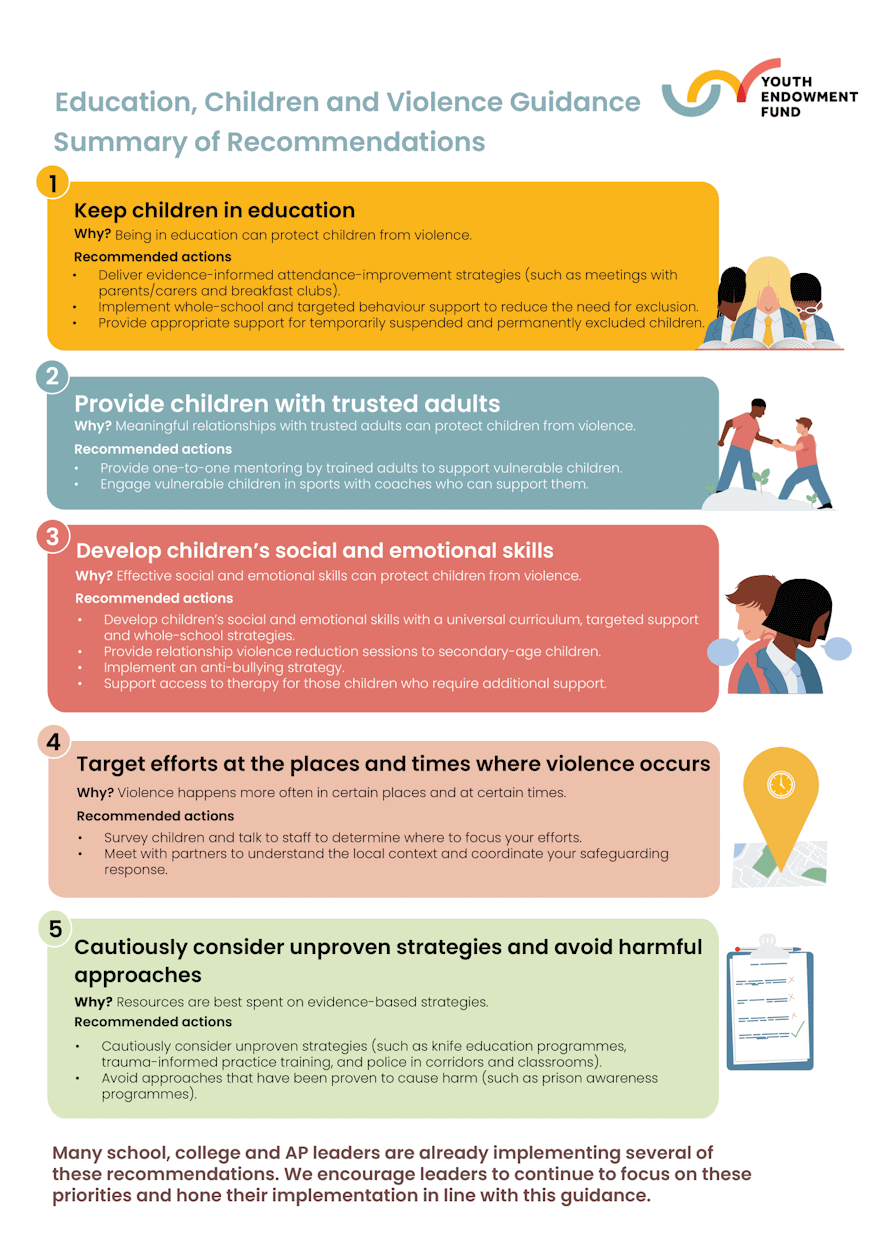
Read the full report here.
The Importance of School Attendance
Unsurprisingly, keeping children in education is top of the list. Promoting a whole-school approach and
delivering attendance improvement strategies are things we advocate for too. We also provide the tools to put them
into practice, so if you’d like to discuss how Studybugs can help with pupil attendance in your setting,
— Lucas Abbott
Free Options for Staff-to-Staff Messaging in School

Sending messages between staff should be easy, quick and cheap. You shouldn’t have to run from one end of the school to get a message to another staff member, but equally, you shouldn’t have to pay through the nose for a system that enables easy messaging.
Below, I’ll run through some free options you might want to consider at your school.
Your first option is the humble email. Perfect for one-to-one or one-to-many messages (just go easy on that reply all button!), it’s easy to organise and act upon messages.
You’ll likely already have a school email address, so there will be no extra costs or accounts to manage. It keeps everything in one place and it’s easy to manage your inbox, but if you get a lot of external emails managing several internal ones too might be a bit much. Email also isn’t the most instant and personal way to communicate.
WhatsApp is great for one-to-one messages and group messages. However, using WhatsApp means using your personal phone, which staff may not like to do, or getting everyone work phones, which your business manager may not like to do! You’ll either have lots of chats going on at once or a very busy group chain, so it’s up to you to consider if either of those would work for you.
Slack
Slack is what we use to communicate remotely at Studybugs. Staff create an account and then can send direct messages and be added to what Slack call ‘Channels’, which are groups any member can message in. You can have several channels set up, eg for year groups, SLT, front gate duty, etc. and everything is stored in one app.
You can use Slack in a web browser, desktop app and a mobile app, so it’s flexible and easy to stay connected. There are a few different price points, but the free version should be sufficient. It’s popular with workplaces for a reason and is definitely worth investigating for your school.
— Lucas Abbott
How to Look After Children’s Wellbeing using Studybugs
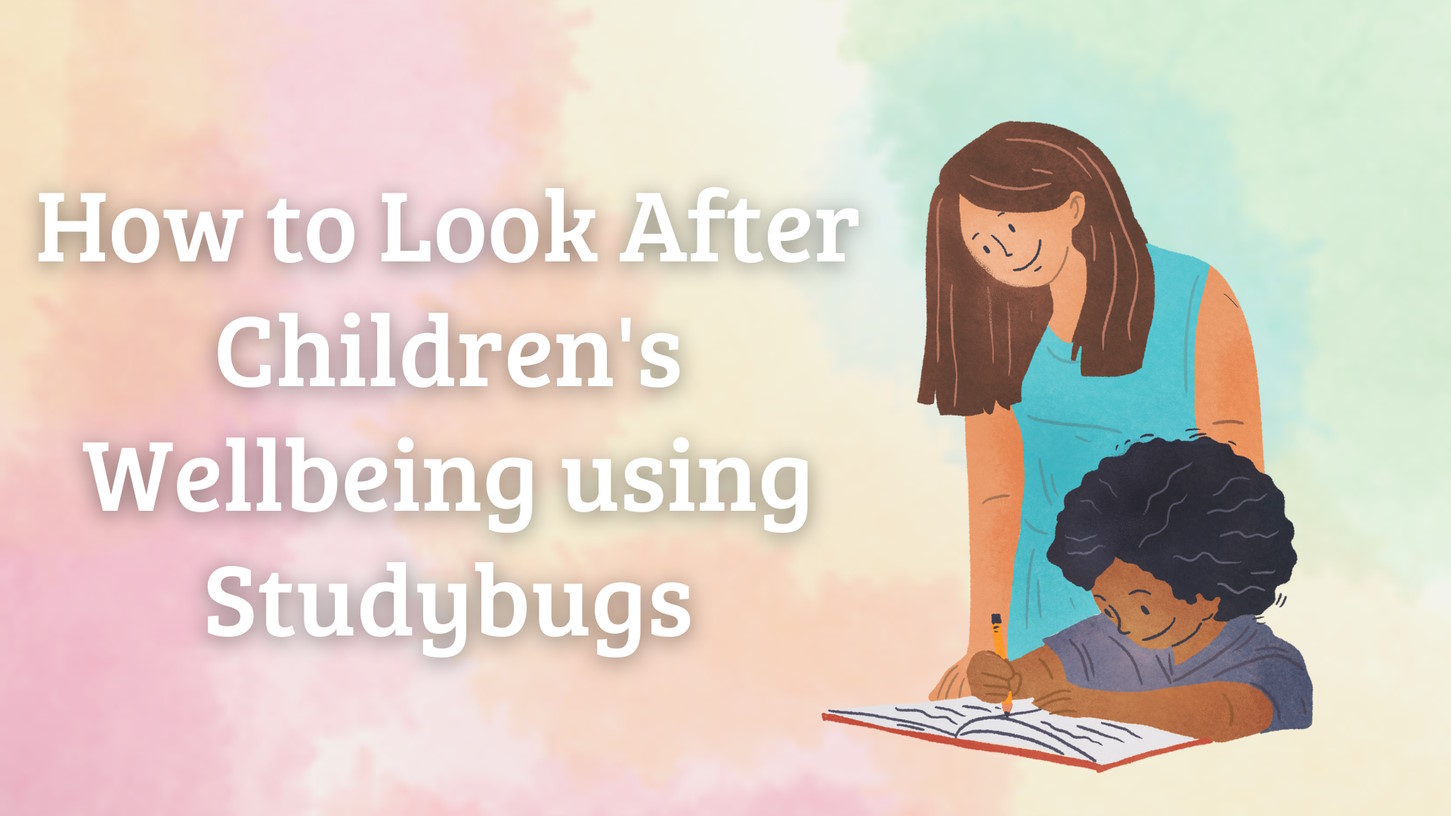
Ensuring children’s wellbeing is one of the things we’re most passionate about at Studybugs. So I want to take this opportunity to guide schools through how you can use Studybugs to protect children’s mental health and keep them happy, healthy and in school.
Set Up Wellbeing Alerts to Spot Issues Early
One straightforward way to keep an eye on children’s wellbeing is to set up wellbeing alerts. Wellbeing alerts work by recognising certain words in absence reports and automatically alerting staff of your choice when they’re mentioned. So when a parent reports a wellbeing concern such as crying, anxiety or fatigue, the relevant staff can immediately follow up.
Spot Patterns of Attendance That Could Indicate an Issue
Many wellbeing issues, such as fatigue, bullying or Emotionally Based School Avoidance (EBSA), can have a negative effect on pupil attendance. At Studybugs, we emphasise early intervention to quickly address the underlying reasons for absence.
Identifying and addressing a wellbeing issue quickly means you can limit the amount of time a child misses school, and of course limit how long they struggle with a wellbeing issue without support.
Spotting troubling patterns of absence could be something like frequent absences after weekends or breaks, year-to-date attendance falling below 95% or regular lateness. Studybugs attendance alerts can help you keep track of those triggers and more, so you can investigate absences further and address the underlying issues.
Engage Parents in their Child’s School Life
Communicating well with parents keeps them engaged. This has huge benefits for pupils, from encouraging good attendance to ensuring homework gets done.
An engaged parent might also notice when their child is behaving differently, or if they seem under a lot of stress. Building strong relationships with parents and having an easy means of communicating with them means they’re more likely to feel comfortable speaking to you if they have any concerns.
For schools using Studybugs, parents will likely be used to getting in touch with the school using Studybugs to report absence. Your school may also use Studybugs to send out messages. Having the option to communicate in a way they're familiar with makes it really easy for parents to drop the school a message if they’re worried about their child’s wellbeing.
Get in Touch to Put Things in Place
If you’d like to discuss adding any wellbeing alerts, attendance alerts or talk about anything else mentioned in
this blog,
— Lucas Abbott
Supporting Children Outside Mainstream Education and Reducing Exclusions
Section 19 of the Education Act outlines local authorities’ responsibilities in finding suitable provision for children that are unable to attend mainstream education. We understand that LAs often have difficulty placing these children and even understanding where they are after they leave mainstream education, making meeting your responsibilities difficult.
To complicate matters, school exclusions are at a 16-year high, the number of children with SEND is increasing, there is a growing number of children that have split timetables, attend multiple settings for their education, attend school out of area or are electively home educated.
It’s vital that all teams can access the right information for the children they are responsible for and that this information is relevant and up to date. That way, they can ensure that the right action is taken, which may even include preventing exclusions in the first place.
Why Are Children Excluded From School?
The primary reason for exclusion is often cited as ‘persistently disruptive behaviour’. However, before resorting to expelling students, we must ask why a child is behaving disruptively in the classroom. Failing to pose this question means failing our young people. Astonishingly, 80% of school exclusions affect children under the care of a social worker.
Can We Prevent Exclusions?
For a child, being excluded from school is the harshest penalty. It not only takes them out of the education system but also ostracises them from society, making them outcasts.
Preventing exclusions has numerous benefits including improving outcomes for children, ensuring their safeguarding and making sure they don’t go missing in education. It would also decrease the pressure on overworked social care teams and help LAs work more efficiently on a smaller number of cases. So how do we prevent exclusions?
One problem is that LAs don’t have visibility of which children are at risk of being excluded. Creating an early warning system to help reduce exclusions is something we’re developing with the LAs we support. We are providing attendance teams with this information early, so they can understand the reasons behind the challenges children are having. This means they can intervene early and prevent exclusions by introducing initiatives such as trauma-informed schools training or mentoring cohorts and children particularly at risk.
Key Challenges of Supporting Children in Alternative Provisions
Of course, avoiding exclusions is not always possible, and there are also other reasons why children might attend an Alternative Provision (AP). A high proportion of children in AP academies, AP free schools and PRUs have identified special educational needs compared to those in mainstream schools: 77.1% of children have a SEN or disability, and 10.4% have SEN statements or EHC plans. This compares to 14.4% and 2.8% in all schools respectively.
One issue for LAs is that it’s complicated to track whether or not children are attending alternative provisions. This is causing many issues, including:
- Safeguarding concerns; many LAs don’t know where the children are because APs are commissioned by multiple different teams and tracking is often done on spreadsheets which are difficult to keep up to date.
- Value for money is not being achieved; Alternative provisions are charging LAs for children who are not attending and money is being spent on home transport services that are not being utilised.
- National data shows that 4.5% of children who attended AP achieved 9-4 passes in English and Mathematics at GCSE, compared to 65.1% in state-funded mainstream schools.
- Provisions may not meet the educational or social requirements of each child. Without measures to track children attending APs, it is very difficult to identify what’s working well and what isn’t.
How Can We Make Sure All Children’s Needs Are Met?
I mentioned earlier that children with social workers make up 80% of school exclusions. We are working with LAs to build out the Studybugs platform to make it easier for you to support these children and reduce exclusions.
For example, we are ensuring that children on CIN and CP plans are highlighted to the schools. This is not something that currently happens automatically. We have projects underway with the National Association of Virtual School Heads (NAVSH) to ensure all children with a social worker are getting the support they need, whatever their setting.
Ensuring children attend their education setting is of course paramount. But so is making sure their care providers know whether or not the child is attending. That’s why Studybugs has developed a system for sending live alerts to social workers so they immediately know when their children have not turned up for school or their alternative setting.
Other vulnerable groups such as children with SEND are also at risk; children with SEND are significantly more likely to experience bullying, EBSA, poor school attendance and poor educational outcomes compared to their peers. Quickly having visibility of children with poor attendance and also the reasons behind poor attendance can enable SEND teams to intervene early and ensure this vulnerable cohort is getting the support they need.
We’d Love to Hear From You
We love talking to local authorities about their needs and how we can help you support all children under your
care. If, in this blog, we’ve touched upon anything that you’d like to discuss, please
— Yvette Lovelock
Data sourced from the DfE’s AP Roadmap.
How to Sustainably Improve Attendance in 5 Steps
With all the media coverage about low school attendance, it’s rightfully seen as an urgent problem that needs addressing. But that doesn’t mean it has a quick fix. We’ve seen many schools add attendance goals to their school improvement plans, which makes sense as improving attendance across a whole school requires time, perseverance and patience.
Whatever improvements you make, you want them to be sustainable. You can’t run staff into the ground to improve attendance immediately or push parents too far with your messaging. So how do you improve attendance in a way that’s sustainable?
Here’s a 5-step guide to do just that.
1. Accurately track attendance and analyse the data effectively
The first step to improving attendance is tracking your attendance accurately. This includes things like keeping registers up to date, staying on top of missing marks and entering absence reports promptly. Without accurate data, you won’t know where to allocate resources and could end up wasting them or missing warning signs.
With your data shipshape, you can then use it to target your actions effectively. This requires monitoring your attendance data to look for trends, spot warning signs and get a full picture of each pupil’s attendance history.
2. Identify where support is needed most
With thorough analysis of your attendance data, you’ll be able to spot patterns and identify where support is needed. You can then provide the appropriate support as per your action plan, whether that’s a conversation with a pupil when their attendance drops, a letter home, or congratulating a pupil for making improvements.
Early action is a great way to stop problems from escalating – or to reinforce positive behaviour – making sure families feel supported.
3. Make sure staff understand their roles and when they need to act
Much like safeguarding, good attendance is everyone’s responsibility. You may have an attendance officer who takes ownership of policies and monitoring attendance, but other staff will play important roles in fostering a culture of good attendance at your school (more on that later). Class teachers or form tutors will have strong relationships with pupils, so may be best placed to start conversations, for example.
Making sure staff get the information and the support they need to fulfil their roles is key. The right staff need to get the right information at the right time in order to act on it quickly and effectively.
4. Improve staff efficiency to free up the necessary time to act
We all know how stretched everyone’s time is, from SLT to classroom staff to the school office. Ensuring you act as efficiently as possible is paramount to being able to go the extra mile when needed. If someone in the office is spending 3 hours every morning recording absences and chasing them, what steps could you take to reduce that time? If teaching time is lost every morning taking the register, how can you speed up that process? With time to think and work on pastoral care, both pupil and staff wellbeing can be improved.
5. Foster a culture of good attendance
Good attendance doesn’t happen in isolation. If only one person is working on improving attendance, no matter how good they are, it’s not going to get the same results as if the whole school’s on board. Good attendance is also related to other elements of school culture – like the school’s curriculum, ethos, behaviour and inclusivity. Making school a safe place with the right ethos helps make pupils feel that attending is worthwhile.
By breaking it down into actionable steps, you can make your goal to improve attendance manageable and
measurable. We’d love to hear from you if you’ve included attendance in your school improvement plan. And please
— Lucas Abbott
Getting the Most From Studybugs Assistant
Please sign in with your school, trust or local authority staff account to see this blog post.
Don’t have a staff account?
If your organisation is registered with Studybugs (or you’re not sure), please
Introducing Cohorts: Compulsory School Age Reporting and More
We’ve been busy behind the scenes building a new, more powerful reporting engine that enables Studybugs to report on cohorts that change over time, such as compulsory school age. We’re calling this capability Cohorts.
This work has been a huge undertaking, delaying our usual flow of new features, but now it’s in place we will be able to release new features more quickly while providing more flexible and powerful reporting options.
Below, I’m going to run through some new and upcoming features made possible by the Cohorts update.
View the Attendance of Compulsory School Age Pupils
The first new feature – for LAs and academy trusts – is that we’ve introduced compulsory school age reporting into three existing commands, plus one new one:
- The school attendance league table
- The register marks breakdown (pie chart)
- Overall attendance across your LA your trust
- How many CSA pupils do we have?
You’ll need to be signed with your LA or trust user account for these links to work.
For the first three of these, the commands now report on compulsory school age pupils by default, but with the option to open it up to “All Pupils” if you wish.
We’ll be CSA-enabling further commands over the coming weeks, for schools as well as LAs and trusts.
Definition of Compulsory School Age
We follow the legal definition of compulsory school age, taking into account how the cohort changes over the course of each year. Note that some other systems approximate CSA by looking at (say) years 1-11, which is easier to calculate, but not strictly correct, so you might see some differences with the numbers in Studybugs. More on this here.
Create Reports for Custom Cohorts (Coming Soon)
The new capabilities will give you greater control over the groups you report on, helping you get the data you need for specific cohorts you define. We’re currently working on enabling you to:
- construct your own cohorts, either by listing the members individually, or by combining other cohorts, and extract reports on these, and
- form cohorts across different types of members (eg children, pupils, schools), and
- extract reports for previous years, accounting for the changes in cohorts over time.
For example, you could have a cohort of Children in Need (CIN) children, another cohort of EHCP pupils, and create a cohort of schools – let’s say, “LA-maintained schools”. Then you could extract a graph of attendance over time for CIN EHCP pupils attending LA-maintained schools.
New Cohorts Are Maintained in Real Time
Behind the scenes, when we encounter a cohort we haven’t seen before, we construct a table of data which we then maintain in real time. So, the first time you request a report for a new cohort, it might take up to a few minutes to generate, but the next time you ask for it, it’ll be near-instant. Here’s how it looks.
We’re Open to Feedback
We welcome
— Jeremy Mabbitt
How to Reduce Persistent Absence at Your School
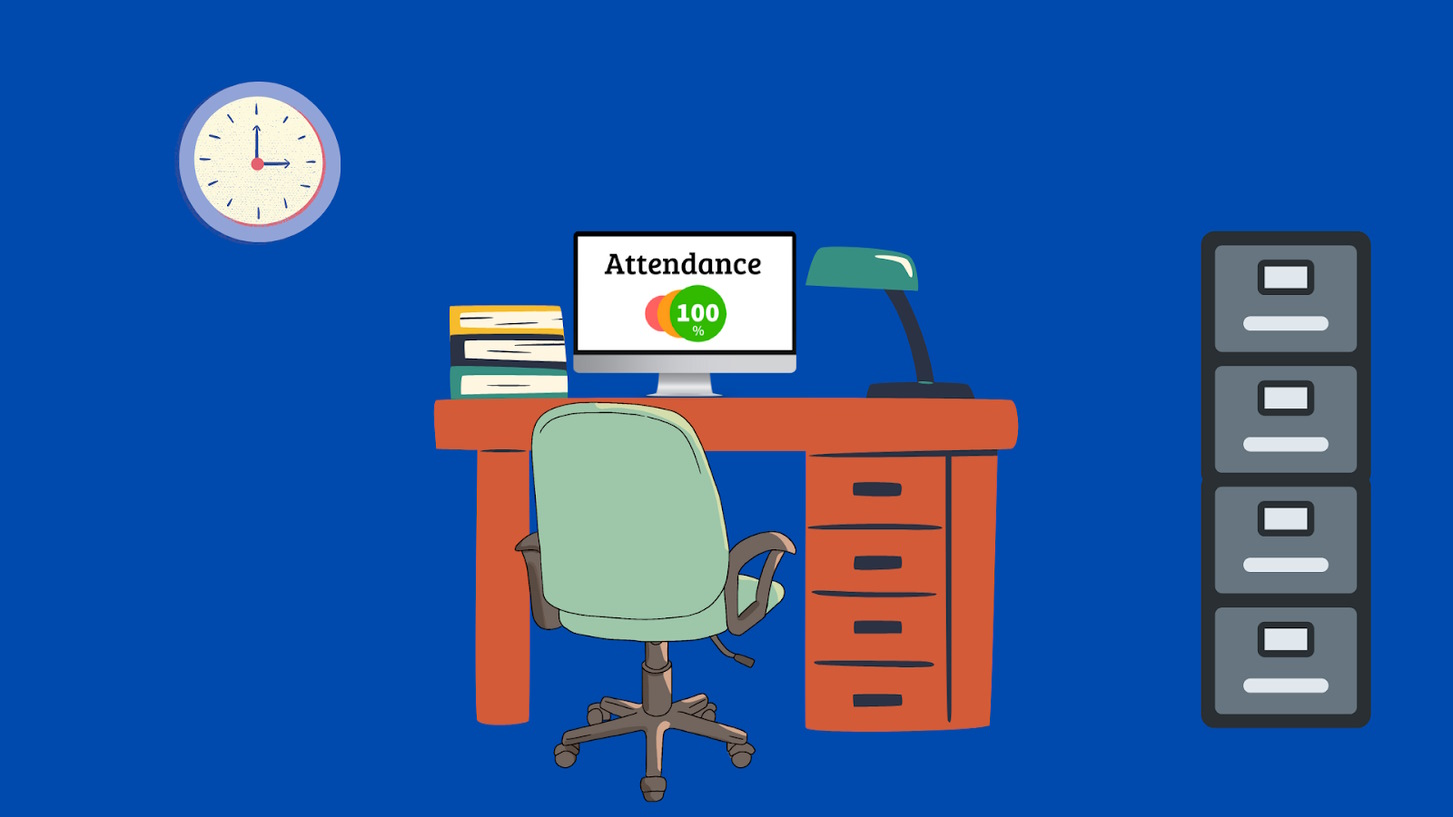
Persistent absence is a complicated issue that can be difficult to address. Because each pupil’s circumstances can be so different, there’s no one-size-fits-all answer to tackling the issue. But there are certain strategies schools can use to inform their approach.
Our research has shown us that you can build an effective approach around five key elements. Download our free resource for an in-depth guide to this approach. Or stay with me now as I do a whistle-stop tour of each point and show how Studybugs can support you.
1. Set Clear Expectations and Communicate Them
Schools that effectively champion good attendance tend to have very clear messages about their expectations. And they communicate these expectations directly and plainly with parents.
How Studybugs helps
Studybugs helps you communicate with parents via a free school-parent messaging platform. Automatic parent alerts also make it easy to notify parents about changes to attendance – positive or negative.
2. Listen to, Support and Challenge Parents When Necessary
Empathy is key when approaching difficult conversations with parents. There could be sensitive barriers preventing good attendance, such as anxiety, financial pressures or the child could be a young carer.
Listening to parents and helping them address any underlying concerns will help you reach agreement over what can be done about an attendance problem. Of course, there will also be occasions when you have to challenge parents. But as you work with them, you can shift the emphasis towards rewarding good attendance.
How Studybugs helps
Studybugs automatically alerts you to potential issues early so you can quickly address them. Instantly accessible, comprehensive data helps you monitor the success of any actions taken and communicate these with parents. Studybugs also keeps a record of messages for you.
3. Get The Right People in Place
Promoting good attendance should be a key part of the school’s culture, which means it’s important that all staff know their role in contributing to this.
How Studybugs helps
We make monitoring attendance easy and can give any staff the access they need to fulfil their role, whether that’s a full view of attendance or alerts for a specific group. Setting up automated parent alerts means you can keep parents informed and help parents understand their roles in making sure their child attends school too.
4. Analyse Trends to Catch Problems Early
The first step to addressing persistent absence is accurately tracking and monitoring pupil attendance, so you can identify pupils at risk of becoming persistently absent, or those who already are. Identifying pupils at risk early means you can take meaningful action earlier and potentially avoid escalation into more intensive interventions.
How Studybugs helps
Monitor live attendance and receive email alerts when certain triggers are met, such as falling below 95% attendance or 2 consecutive late marks in the register. Staff get powerful reporting tools to instantly call up information you need such as an absence breakdown, attendance heatmap or your PA rate. You can also set up parent alerts to automatically notify parents when their child misses school, is late or their attendance drops below a threshold you choose.
5. Maintain Procedures Diligently
Tackling persistent absence is not an overnight fix. It requires time, commitment and patience. And that doesn’t go away after a problem is addressed. Having an effective and consistent attendance strategy is key.
How Studybugs helps
Studybugs enables a whole-school approach to managing pupil attendance. We provide the tools you need to create an effective strategy and the data you need to put it into action.
Get in Touch For Some Help
If you’d like to talk to a Schools Consultant for some attendance guidance, please
— Lucas Abbott
Helping Parents Understand Why Good Attendance is Important

One of the big talking points of this school year so far has been how parents are no longer treating school attendance as a priority.
It’s something the DfE has recognised and they’ve provided a toolkit to help schools improve their messaging around attendance. Working on finding the right message is, of course, key to improving communication with parents. But the right message is only part of the solution.
As any marketer will tell you, delivering a message that gets results hinges on three things:
Sending the right message to the right person at the right time.
These are tried and tested principles that could really help schools improve their communication with parents. So, how do you make sure your communication ticks those boxes?
The Right Message
Reports suggest that parents have lost sight of the importance of good attendance. It seems that the once popular “every day matters” message no longer resonates with parents after Covid lockdowns, remote learning and quarantining.
So, finding the right message is key to helping parents understand why attendance matters and why, importantly, they should actively ensure their child attends school as much as possible.
There are a lot of factors that come into play when deciding on the right messaging, and it may be different for every school. One good way to find the right messaging is to discuss what good attendance means to your staff and pupils. What are your school values? Where does attendance fit in to that?
You could even run a focus group with pupils to give them the opportunity to explore what attending school means to them. You could then base your messaging on the results of this.
The Right Person
Thankfully, this one’s very easy. You need to contact the person responsible for making sure a child is attending school. This is usually their parent or guardian. But it’s also important to consider the impact of speaking to pupils themselves, particularly as they get older.
The Right Time
With the right message written and the right person decided on, the last thing is the right time. This is crucial to getting good results. Make contact too late and you might have more difficulty changing an engrained problem. Message too early or at a random time, and parents may just dismiss what you have to say.
So how do you find the right time?
An effective way to choose the right time is to use live attendance data to help you. For example, when a pupil’s attendance falls below a certain threshold, that triggers a message to be sent to their parents. That means that you’re sending your message right at the time when it should have the biggest impact.
Studybugs has developed automated alerts for parents that do exactly that. You set the trigger, create your template and it will automatically be sent whenever a pupil meets the criteria. See some examples.
You could also think about sending messages that tie in with your school calendar. For example, reiterating the need for good attendance when returning from school holidays.
Also Consider How You’ll Deliver The Message
Alongside all the points above, you’ll need to consider how you contact parents about attendance. Do you send letters home? Call them? Try to catch them at the school gate?
For schools using Studybugs, you’ll know that sending messages via Studybugs means your messages go straight to a parent’s phone (or email address if they haven’t signed up). It’s a simple way to make sure your message reaches them and it includes read receipts so you’ll know when they’ve picked it up.
Starting with Studybugs messages and escalating to phone calls and in-person meetings is a solid starting point for your ‘how to make contact’ strategy.
If you don’t yet use Studybugs, you can access our messaging features for free. Register to get started.
One Final Tip: Experiment!
Another thing schools could take from marketing professionals is to test your messages. Does a certain word elicit a stronger response? Does counting absence by number of days resonate more than a percentage? Does it work better to send a message when a pupil falls below 95%, 93% attendance or both?
Part of a strong attendance policy is the ongoing maintenance and improvement of it, so you can keep amending as you go to make sure your messages continue to perform strongly.
Hopefully, this article has got you thinking about ways you can improve your messaging around attendance.
If you’d like to speak to one of the team at Studybugs about improving parental engagement, please
— Lucas Abbott
Share Pupil Absence With Parents By Number of Days Absent
Please sign in with your school, trust or local authority staff account to see this blog post.
Don’t have a staff account?
If your organisation is registered with Studybugs (or you’re not sure), please
Why Missing Marks Are a Problem and How To Correct Them

We often find missing marks in the registers when we first meet with schools, sometimes totalling in the thousands! Missing marks can be time-consuming to correct at best and a big safeguarding problem at worst, so it’s important to take steps to correct them quickly.
Early in the year is the perfect time to make sure your processes for handling missing marks are shipshape, as tackling any problems now means they’ll be much easier and quicker to fix.
But why do they build up in the first place? Here we take a look at why and outline what you can do to prevent it happening.
Why Do Missing Marks Build Up?
Missing marks generally build up because many systems ignore them or treat them as “not required”, meaning if you’re not looking for them you might not even know they’re there. This practice can lead to incomplete or incorrect data and nasty surprises later.
Every session for every pupil should have an appropriate code filled in; if attendance is genuinely not required, there are specific codes that account for that (X for non-compulsory school age, for example). You can find a full list of register codes and their uses on pages 55 to 65 of the DfE’s “working together” guidance.
Why Is It Important to Keep On Top of Missing Marks?
First of all, any missing mark means a child’s whereabouts are not accounted for. This is most acutely important on the day of the mark in question in order to ensure their safety.
After that day, missing marks will affect a pupil’s year-to-date attendance. This is where the practice of systems ignoring them is misleading, as your system might tell you a pupil’s attendance is one thing, but the missing marks mean it’s actually lower. Studybugs treats missing marks as absence, giving a more accurate picture of attendance.
The other problem with marks building up is that you’re less likely to be able to accurately correct them after a lot of time has passed.
How Can You Correct Missing Marks?
The best way to correct missing marks is to resolve them as they occur. This can be done with a combination of making sure all teachers correctly complete each register and regularly checking for missing marks at whole-school level. Studybugs can help you with both of these.
Resolving as you go means you don’t need to correct them in bulk, for example at census time, ahead of an inspection or at the end of the year. Studybugs schools can receive daily alerts listing any missing marks so they can correct their data while it’s still fresh. They can also view all missing marks at any time.
For primary schools using Studybugs Registers, teachers will also see a warning on their register if it hasn’t been completed.

Summary
Keeping on top of missing marks ensures all children are accounted for and that genuine unexplained absences can be chased. It also means your data is complete and there are no nasty surprises later.
I hope this has been helpful. If you have any questions about missing marks, please
— Lucas Abbott
Should You Use One IT System for Everything?

The EdTech world is large and varied, and it can be quite daunting trying to keep on top of all the different costs, licences, staff access, passwords, training and everything else that comes with using several systems.
Which leads to the obvious question:
Can I use one central system for everything?
But perhaps the question should be:
Is it actually better to use one system for everything?
Let’s take a look.
One System Means Only One Integration
A benefit to a school IT system that does everything is that once it’s set up, you don’t need to worry about different programmes talking to each other, because everything’s all in one place. The downside of course is that if that one system goes down, it takes everything with it.
Using One System Can Be Simpler to Manage
Another benefit is that one system is simpler to manage. If you have one login, one subscription, one renewal date, that certainly gives you fewer things to worry about.
Of course, multiple logins may not be a big issue anyway as many single purpose systems now support SSO (single sign-on) through your workplace login (such as Google Workspace or Microsoft Azure).
Single Purpose Systems Can Be More Comprehensive
To state the obvious, the biggest benefit to single purpose systems is that they are excellent at one thing. Their focus isn’t divided, so they can commit to making their particular service the best it can be.
You’d be hard pressed to find a system that genuinely offers the best solution for every job from attendance to behaviour management, timetabling to payments. Using different systems means that you are likely to get more out of each one and have a better experience doing so.
Using Separate Systems Gives You More Flexibility
Another benefit of keeping your school IT solutions separate is that you’re not tied in to one system and can make individual changes where necessary. So if your supplier hikes up their prices, or a particular service no longer meets your needs, you can make a switch.
With one system, if there’s a key element that no longer works well for you, you either have to pay twice by also buying that part separately, or you have to change your whole system.
Keeping Things Separate Gives Staff More Autonomy
Keeping school IT systems separate means that you can give staff more choice over what they use. For example, if your Attendance Officer is already familiar with some particular school attendance software, they can request to use that without it affecting what other staff members use for their roles.
Considering the Benefits of Each System
If you’re looking solely at the features of each system, you’ll be able to check these off against what your school needs. But that’s not always the full picture.
Many systems offer similar features on paper, but what sets them apart is the benefits that come from the unique way they deliver them. As a slightly silly example, both an app and a carrier pigeon could provide parent communication as a feature. But the benefits of each would be vastly different.

When comparing systems, it’s important to consider the benefits each provider’s features offer, whether that’s saving time, a more comprehensive understanding, easier user experience, etc.
So, What’s the Verdict?
Ultimately, you’ll find the best IT solutions for your school by matching up the benefits and features of any system against your school’s needs.
But by considering first whether one central platform or a few bespoke systems is best for you, you’ll be able to make an informed decision that’s best for continuing school improvement.
— Lucas Abbott
How to Edit Your Lunch Menu
Please sign in with your school, trust or local authority staff account to see this blog post.
Don’t have a staff account?
If your organisation is registered with Studybugs (or you’re not sure), please
New Parent Alerts Now Available
Please sign in with your school, trust or local authority staff account to see this blog post.
Don’t have a staff account?
If your organisation is registered with Studybugs (or you’re not sure), please
How to Set Up Parent Alerts
Please sign in with your school, trust or local authority staff account to see this blog post.
Don’t have a staff account?
If your organisation is registered with Studybugs (or you’re not sure), please
Why Are School Absences Still So High?

Absence is one of the defining problems of this school year. So much so that it’s consistently made national news. But what are the reasons behind this high absence rate? And more importantly, what can we do about it?
Attendance Hasn’t Recovered Since the Pandemic
Although Covid is a no longer a major topic of conversation, it’s a constant presence in discussions around school attendance. Because it’s a watershed. There’s attendance before Covid and attendance after. And they’re distinctly different.
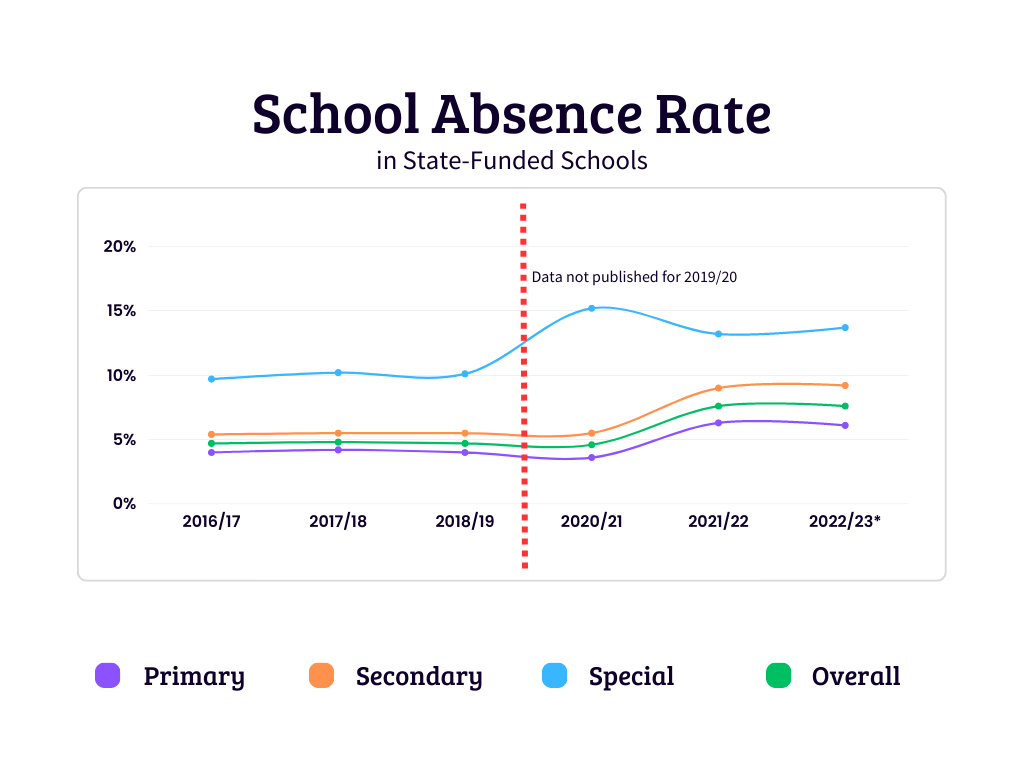
The overall absence rate is 7.6% across all state-funded schools (according to government statistics from May 2023). This is compared to 4.7% in the year before the pandemic.
It’s clear that the pandemic has had a massive impact on school attendance. But why is absence still so high two years after the last Covid school closures?
What Reasons Are Given for High Absence Rates?
There are a number of theories being bandied about.
- Attitudes to attendance have changed since Covid
- Pupil anxiety is keeping them off school
- There’s a rise in trauma, deprivation and poverty
- Parents are keeping children off with minor ailments
- Parents are working from home on Fridays and keeping their children off
- Budget cuts have led to reduced pastoral support
- Local authorities (LAs) aren’t able to keep up with demand
It’s quite a list, spanning from children’s mental health to blaming parents to systemic pressures. Is there one stand-out reason? Or is it that they’re all combining to create one big absence-inducing cocktail? Are some of them even true?
I don’t have the answers to all those questions. And from what I’ve seen, no one else seems to either. With that in mind, all we can do is focus on:
- What we know.
- What we can act on.
What We Know:
Mental Health Issues are Causing Absences
Studybugs is uniquely placed to offer insight into illness absences, as we collect anonymised illness data from absence reports across the country. Earlier this year, we did some research into mental health absences and found that, as a percentage of overall illness absences, they’re considerably higher than before. In fact, the number of mental health related reports per user is up by 131% since before the pandemic.
What We Know:
Illness Absences are Up on Pre-Covid Levels
Looking at Studybugs data for illness absences, compared to the 2018/19 school year (the last full school year before Covid), there has been:
- a 46% increase in the number of sick reports per 1,000 users (adjusted for the school year) that mention “a cold”
- an 89% increase in sick reports that mention “cough”
- a 43% increase in sick reports that mention “flu”
- a 17% increase in “headache”
- a 427% increase in “fatigue”
- a 325% increase in “stomach bug”
But what about the claim that parents are keeping children off with minor ailments?
Looking at data above, it does seem that cold symptoms make up a higher number of reports than before. We can’t know for sure if this is down to minor ailments or symptoms of more severe illnesses, but it certainly seems clear that parents are reporting more illness.
According to statistics from DfE attendance returns, illness absences are at 3.7% compared to 2.5% pre-pandemic. December’s attendance was particularly affected with several illness peaking at the same time, whereas they’re usually more spread out across the season.
So knowing this, what can we do to address high absence rates?
What We Can Act On:
Helping Pupils with Their Mental Health
Schools and LAs will already have processes for helping pupils suffering with their mental health, but with the high number of cases it can be difficult for even the most equipped places to keep up.
Making sure your processes are efficient and effective is key to ensuring you spot problems early and can support pupils promptly. For example, receiving automatic alerts when mental health key words appear in absence reports could help you identify pupils needing support early.
What We Can Act On:
Coping with Budget Cuts and Understaffing
With too many tasks for too few people, it’s no surprise schools and LAs are feeling under pressure. Using technology can be a low-cost way to plug gaps and help staff have the time they need to make a big impact. Whether that’s automating attendance tasks at school or increasing efficiency at an LA level.
Maximising Attendance is More Important Than Ever
With so many unknowns and elements out of your control, the best thing you can do is make sure you’re doing all you can to address everything that is under your control. This includes:
- Putting processes in place to support pupils’ mental health
- Educating parents and pupils on the need for good attendance
- Effectively monitoring attendance and acting quickly when issues arise
- Making sure staff are adequately supported in fulfilling their roles around attendance
These are all achievable and actionable things you can do to raise and maintain good attendance.
And if you’re struggling with a certain aspect of attendance, don’t be afraid to ask for help. If you’ve got
any issues or want to talk through your processes with a Studybugs Schools Consultant, just
— Lucas Abbott
Emotionally Based School Avoidance: What Can You Do to Help?

Sometimes still referred to as school refusal, Emotionally Based School Avoidance (EBSA) is a significant problem that affects many children, families and schools. According to a 2015 study1, approximately 1-2% of the school population are absent due to emotional reasons.
In cases of EBSA, children find the idea of attending school distressing. It could be something social or peer-related, difficulties with the curriculum, a problem with the physical environment, or something external.
This can lead to long absences and therefore a detrimental effect on attainment, social development and mental health, so it’s critical to act early and sensitively to address EBSA.
So, what can you do as a school?
Recognise the Signs Early
EBSA can be difficult to identify because some of the presenting behaviours are similar to other attendance issues, such as truancy. But EBSA differs because of the emotional root of those behaviours, so attempting interventions that don’t address the underlying emotion are likely to be ineffective at best and potentially even deepen anxiety.
Indicators of EBSA include:
- A change in punctuality or attendance
- Frequent complaints of illness before or during school
- Regular absences without indication of anti-social behaviour
- Reduced engagement in school activities
- Social isolation
- Lack of confidence
- Negative conversations about school
- A change in behaviour
- A pattern of absences following weekends and holidays
Recognising EBSA is yet another reason why it’s critical for schools to have robust systems in place for monitoring pupil attendance. You need to make sure you’re able to spot patterns, notify the right staff at the right time, and take appropriate action to address issues early. That’s what Studybugs Attendance is all about.
It’s also important to place a strong emphasis on supporting pupils’ mental health. For this, you might be interested in Studybugs Wellbeing, an early-warning system that notifies you when a pupil is reported absent for a mental health-related reason, such as anxiety, crying or fatigue.
Take Prompt Action
It’s critical to act early if you notice signs of EBSA. The longer it goes on, the more entrenched the difficulties and behaviours become, making it harder to reach a positive outcome.
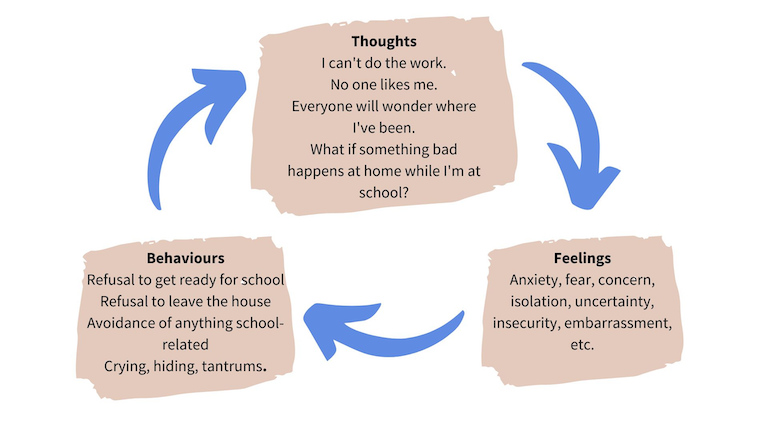
Once you’re satisfied that EBSA is the cause of absence, you can put together a plan to address it.
Work With the Pupil and Their Caregivers
When you’ve identified behaviours that indicate EBSA, it’s time to speak to the pupil and their parents or guardians to put together a plan to support them. It’s really important that any parents or guardians are supported in their role, as a number of the coping strategies will be influenced by their relationship; for example, secure attachment, awareness of anxiety and factors that trigger it, actively listening and encouraging their child to share.
Parents may also need their own support. They might find it hard to talk about the difficulties they have getting their child to school. Or the EBSA might be triggered by something home-related, which they may find difficult to talk about, like a divorce or separation. As a school, you can help by keeping regular contact with parents and agreeing how and when you’ll keep in touch.
You can also share resources with parents to help them develop their understanding of EBSA and their role in addressing it, either as a preventative measure or when EBSA is identified.
When you come to putting together a plan, make sure it’s agreed with the parents or guardians, the pupil, and that any staff who come into contact with the pupil are aware.
Involve the Child in Their Return to School Approach
Not Fine in School2 champion a child-led support plan to encourage children back to school.
Any approach will need to be tailored to the individual, but might include elements such as a temporarily reduced timetable, remote learning, or an alternative space for the child to work in. Working with the child and their parents or guardians will help you come up with a plan that best suits the child’s needs.
The plan for returning to school should be realistic and flexible. You should also be prepared for difficulties in implementing it and consider where there may be sticking points and what you can do to solve them. You may also consider engaging outside agencies if the problem is particularly engrained or you need additional support.
If there are setbacks, then simply work towards returning to the plan when possible. Each day is a new day. The important thing is to be consistent with what you want to achieve and to be united with the parents; any concerns should be discussed separately and not shared with the child.
Regularly Review Your Plan
Keep on top of how your plan is working, make a note of progress and any setbacks so you know if you need to make any changes. Reviewing should also involve the child and their parents. It’s a good opportunity for you all to celebrate successes and talk through things you’re finding difficult.
Hopefully, the review process will be positive for everyone as you see concrete progress being made!
The Relationship between EBSA and SEND
Not Fine in School2 reference the often overlooked correlation between SEND and anxiety, citing various sources. Autism Spectrum Disorders and Sensory Processing Disorders in particular can lead to anxiety at school, which can in turn lead to EBSA.
It’s important to consider how anxiety might also need addressing alongside SEN in any support plans or EHCPs, particularly if there are ongoing issues with attendance, which could indicate that the child’s needs are not being met.
About This Guide
This guide has been put together by Studybugs to help schools get to grips with the basics of EBSA. We’ve used a number of resources to compile this post; for guidance that digs furthers into the specifics, including sample return to school plans, please see the resources below.
Studybugs enables a whole-school approach to pastoral care. Tools like Studybugs Attendance and Studybugs Wellbeing make it easy to monitor pupil attendance and children’s health and wellbeing, create an action plan, maximise pupil attendance, and ultimately keep children happy, healthy and in school.
Resources:
1Coping with life by coping with school: School refusal in young people, from Educational Psychology, edited by Tony Cline, Anthea Gulliford and Susan Birch.
Waterford: School Refusal Good Practice Guide for Schools
Hampshire Services: Emotionally Based School Avoidance
Roscommon School Refusal Resource Pack
— Lucas Abbott
Mental Health-Related School Absences: The 2022/23 Report
This Children’s Mental Health Week, we’re taking a look at school absences due to mental health.
Before we get into the numbers, just a quick note on the data: the figures used for this report are based on illness absences reported by parents via Studybugs. The data comes directly from parents and has been collected anonymously with their permission. This data is unique to Studybugs and published for the first time here. See ‘Where Does This Data Come From?’ below for more detail.
What we’ve noticed is that the number of mental health reports we’re processing has climbed significantly since pre-Covid times and has remained stubbornly high since.
See for yourself below.
The Overall Picture
As you can see from the graph above, following the Covid-19 school closures, many more parents have been mentioning mental-health-related terms in their absence reports to schools. The number has more than doubled since before Covid, and remains high this year.
Looking into the data, there are some further interesting points worth calling out.
The Story This Year
Compared to 2018/19 (the last full year before Covid-19 school closures), several symptoms and conditions make up a higher percentage of all illness absences, including anxiety, fatigue, stress and suicidal.
What’s interesting is the contrast with the previous school year (2021/22). In both of these post-Covid years, the total number of mental health illness absences is higher, but there are differences between the specific complaints. The most notable of these is ‘fatigue’, which made up 1.46% of all sick reports last year, but 0.76% this year.
What Does This Mean For Schools, Trusts and Local Authorities?
As with all school absence, it’s important to identify the underlying reasons for absence and to intervene early to address them. With absences due to mental health, consider how your attendance policies address mental health and what you can do to support pupils in this respect. The first step is, of course, identifying where there are problems.
Act Now to Protect Pupils’ Mental Health
That’s where Studybugs can help. As well as tracking symptoms, Studybugs provides tools for schools, trusts and local authorities to address the underlying reasons for absence, including mental health.
We can monitor absences and attendance trends, drawing your attention to any cases you need to investigate. This makes it possible to spot problems early and quickly take action to address them.
To discuss how Studybugs can support your efforts,
Where Does This Data Come From?
The figures used for this report are based on an analysis of particular trigger terms in absence reports submitted by parents via Studybugs. No school data is included in this analysis.
Over the past few years we’ve processed nearly two million such reports and have built up a unique perspective on the illnesses underpinning school absence.
If you would like to see the (anonymised and aggregated) underlying data behind the figures mentioned above
— Lucas Abbott
How to Use Studybugs to Provide Effective, Targeted Support to Schools
Local authorities and schools (of all types) are expected to have regular “Targeting Support Meetings” at least termly. But with so many schools to meet, it’s hard enough to even fulfil the requirement to meet, let alone identify where support is most needed.
How can you be expected to effectively target support when your picture of schools’ needs is incomplete?
That’s where Studybugs comes in. The tools we provide help you quickly identify where support is most needed, so you can make better use of your resources and give more comprehensive support to schools and pupils.
Here’s a three step guide to using Studybugs to help you target support more effectively.
Step 1: Prioritise Where You Can Make The Biggest Impact
Studybugs has been specifically designed for local authorities to take the work out of data analysis. It gives all the relevant teams information they can act upon.
As well as a complete overview of school attendance, you can quickly drill down into the data to identify the issues where you can provide support. For example, by looking at schools with severely absent pupils.
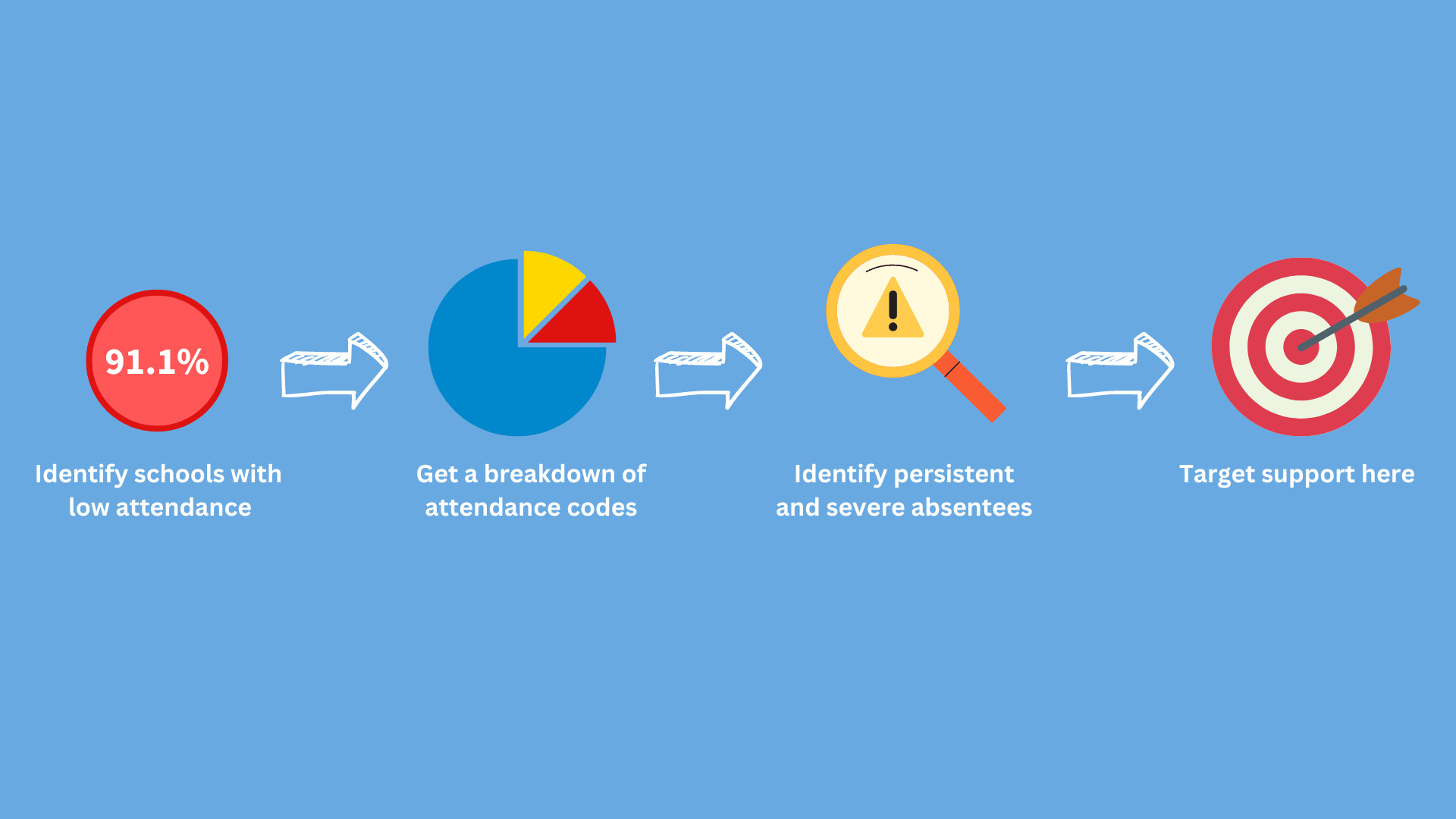
With the relevant information in hand, you can quickly prioritise which schools you need to work with first and which pupils need the most support.
Step 2: Have Informed Meetings With Schools
Being able to prepare properly ahead of a meeting means you’ll have more targeted, shorter meetings with schools where you can achieve more.
By bringing live attendance data to your termly Targeting Support Meetings, you can share how each school compares with their peers and the reasons for their current attendance position. You can also use our web portal to securely drill down into the attendance data for each school, pupil cohort, and individual pupil right there in the meeting.
All this makes it easier to use these meetings to work collaboratively with school attendance leads and agree what support the LA will provide – leading to a better outcome for the school and also meeting the requirements set out in the DfE guidance.
Step 3: Easily Track Actions and Monitor Improvements
Studybugs provides a secure, central location for local authorities and schools to log their actions. By having a shared platform to coordinate actions – and alert relevant staff (school and LA) when action is needed – early intervention can be taken to nip problems in the bud.
Actions can quickly and easily be monitored by both LA and school teams, giving you a secure place to manage improvement plans and determine their effectiveness.
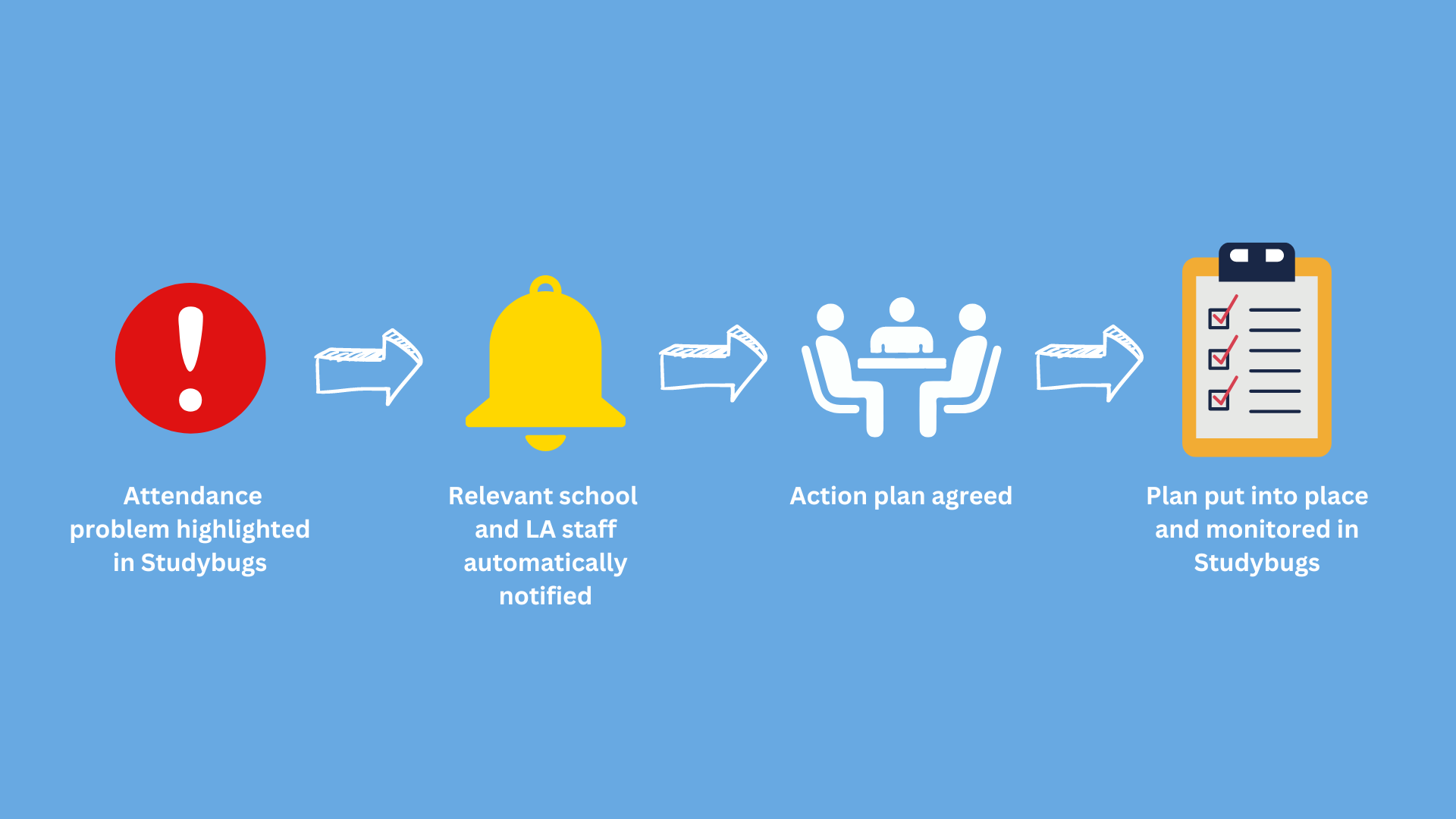
It helps you identify what is working well and where changes need to be made, so that when you next meet with a school, you’re both already aware of where you stand, making subsequent meetings quicker and more constructive.
See It to Believe It
Many local authorities have already started using Studybugs and have quickly achieved 100% school participation, so they’re already seeing the benefits. Get in touch to talk through how we can help you make a bigger impact too.
— Lucas Abbott
How to Share Studybugs Assistant Links With Your Colleagues
Please sign in with your school, trust or local authority staff account to see this blog post.
Don’t have a staff account?
If your organisation is registered with Studybugs (or you’re not sure), please
3 Easy Ways to Reduce Paper Use at School

It’s unrealistic to expect that a school could go completely paperless. But there are ways to reduce the amount of paper you use, which come with some attractive benefits:
- Improve organisation and storage
- Save time on lengthy, paper-based processes
- Store documents more securely
- Reduce waste and improve school sustainability
- Cut costs on paper and printing
So, how can you make it happen?
1: Take School-Parent Communication Online

Keeping parents engaged in their child’s school life is critical for so many reasons – from promoting good attendance to keeping children happy at school. So it’s vital that you ensure your communication with parents is clear and engaging.
Letters home can get squashed at the bottom of a backpack. Or lost. Then all that time you spent printing and photocopying goes to waste and, worst of all, the message doesn’t even get read.
Bringing your communication online means you can reliably reach parents by sending messages directly to their phone or email. For everything from an absence chaser to a full colour newsletter, you’ll be able to keep parents informed and engaged while reducing the amount of time and resources it takes you to communicate with them.
There are a number of digital messaging platforms you can use for school-parent messaging, with varying features and costs. For example, Studybugs offers a free messaging platform and an optional free parent app. Zero paper, instant notifications, engaged parents.
2: Securely Store Records Online
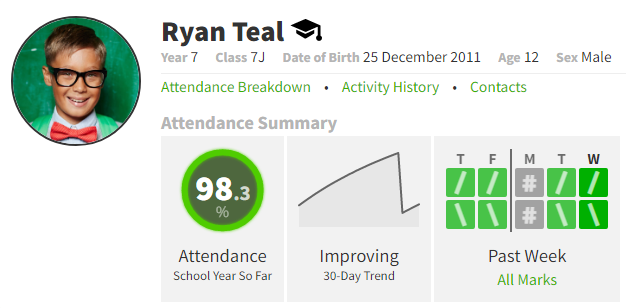
We come across a fair number of schools who print off information that could be easily kept online, and in some cases already is.
Your MIS stores a wealth of information from pupil attendance to contact records, although we do appreciate that MISs aren’t always easy to navigate. But that doesn’t mean you need to resort to paper for easy access to the information you need.
It’s definitely worth looking beyond your MIS to other platforms that store and display data in an easily accessible way, without the need to run complicated reports or print anything out.
3: Primary School? It’s Time To Ditch Paper Registers
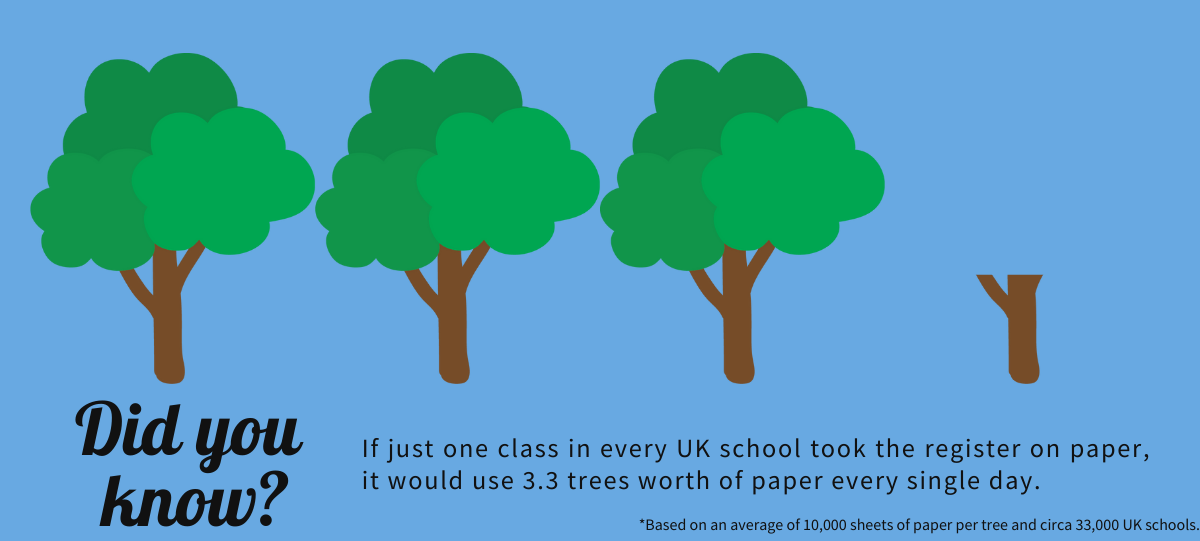
It’s easy to make the change to online registers. Many MISs let you enter the register directly, but you could make it even easier (and more fun!) for staff and pupils by using Studybugs.
Studybugs Registers allows children to self-register as they enter the classroom. It makes registration fun and super quick. Marks are automatically entered into your MIS and children can choose their lunch with just one tap. These are automatically emailed to your kitchen staff, so there’s no need to print off lunch choices either.

Conclusion
They may sound like simple steps, but there are still schools who keep processes on paper when they could easily do the same thing digitally.
Studybugs provides all the tools you need to easily manage pupil attendance and registers, messaging parents,
children’s health and wellbeing and more completely online. If you don’t use Studybugs already,
— Lucas Abbott
Message Personalisation
Please sign in with your school, trust or local authority staff account to see this blog post.
Don’t have a staff account?
If your organisation is registered with Studybugs (or you’re not sure), please
How to Create and Manage Messaging Groups
Please sign in with your school, trust or local authority staff account to see this blog post.
Don’t have a staff account?
If your organisation is registered with Studybugs (or you’re not sure), please
Getting Started with Message Templates
Please sign in with your school, trust or local authority staff account to see this blog post.
Don’t have a staff account?
If your organisation is registered with Studybugs (or you’re not sure), please
Digging Into the Reasons for Absence
Please sign in with your school, trust or local authority staff account to see this blog post.
Don’t have a staff account?
If your organisation is registered with Studybugs (or you’re not sure), please
Attendance Coding Changes
For the 2021/22 school year, the DfE has made some changes to its guidance on coding Covid absences. Here we’ll explain these changes and how they’re handled in Studybugs.
Sc and Is are no more (well, almost… )
“Isolation due to a case at school” (Studybugs code
“Isolation due to a case outside school” (Studybugs code
You can still use these codes in Studybugs (as you might be editing old registers) but a warning message now
appears. We suggest that if a parent is keeping their child in isolation unnecessarily, you consider using code
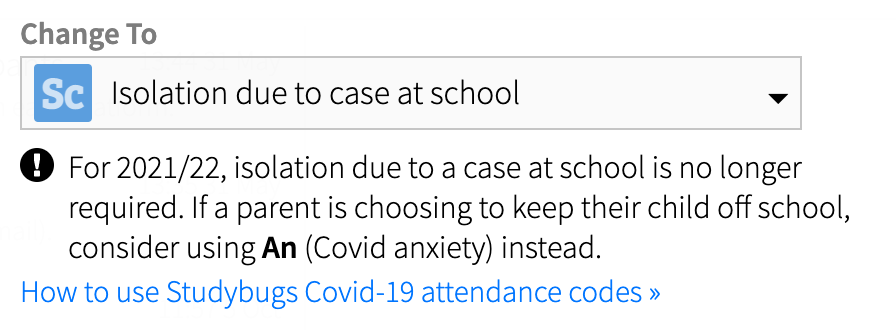
Outbreak Management – Ou
The DfE are clearly anticipating that local Directors of Public Health might need to introduce isolation measures
as part of local “outbreak management”, as they have introduced a new statutory code for this. In Studybugs we’ve
therefore added a new code
Statutory Codes
As ever, Studybugs codes map to the correct DfE codes automatically, so you don’t have to worry about this. This works even as the DfE codes change over time, our aim always being to keep things as simple as possible for you.
You can find full details of the Studybugs codes, and how we handle statutory coding, here.
Oh, and if you’d like to have your attendance officer (and any other staff) alerted when the new Covid codes – or the old ones – are used, just Ask a human and we’ll set this up for you.
Printing Fire Registers
Please sign in with your school, trust or local authority staff account to see this blog post.
Don’t have a staff account?
If your organisation is registered with Studybugs (or you’re not sure), please
Call Up Live Attendance Reports
Please sign in with your school, trust or local authority staff account to see this blog post.
Don’t have a staff account?
If your organisation is registered with Studybugs (or you’re not sure), please
Introducing Parent Time: Video Meetings for Schools and Parents
Please sign in with your school, trust or local authority staff account to see this blog post.
Don’t have a staff account?
If your organisation is registered with Studybugs (or you’re not sure), please
Topics and Groups in Parent Time
Please sign in with your school, trust or local authority staff account to see this blog post.
Don’t have a staff account?
If your organisation is registered with Studybugs (or you’re not sure), please
Remote Learner Attendance
By popular demand, today we’re introducing new tools for tracking the ‘virtual’ attendance of remote learners – that is, pupils working from home due to lockdowns.
Central to this is a new set of attendance codes that let you monitor attendance in the same way you do for in-person learners – helping identify safeguarding or other attendance patterns early so you can take prompt action.
Show me the codes already!
There are eight new codes in all, which mirror standard attendance codes and are distinguished by a dark background representing a stylised video-call box.
| Studybugs Code | Label |
|---|---|
| Remote learner – no mark | |
| Remote learner – present | |
| Remote learner – absent, reason unknown | |
| Remote learner – other unauthorised absence | |
| Remote learner – ill | |
| Remote learner – confirmed case of Covid-19 | |
| Remote learner – medical appointment | |
| Remote learner – other authorised absence |
As with our other Covid-19 attendance codes, the remote learner codes let schools simply record reality, without having to worry continually about the DfE’s latest statutory reporting policies. All the new attendance codes are automatically handled in the correct way (which currently means they’ll be entered in your MIS as “X” codes).
How do I get going?
Studybugs Registers is the easiest way to get started.
First, bulk mark all remote learners with the
Classes and bubbles can be set up however you like – remote-learner-only classes, or combined in-person and remote classes, depending on how your teachers will be teaching.
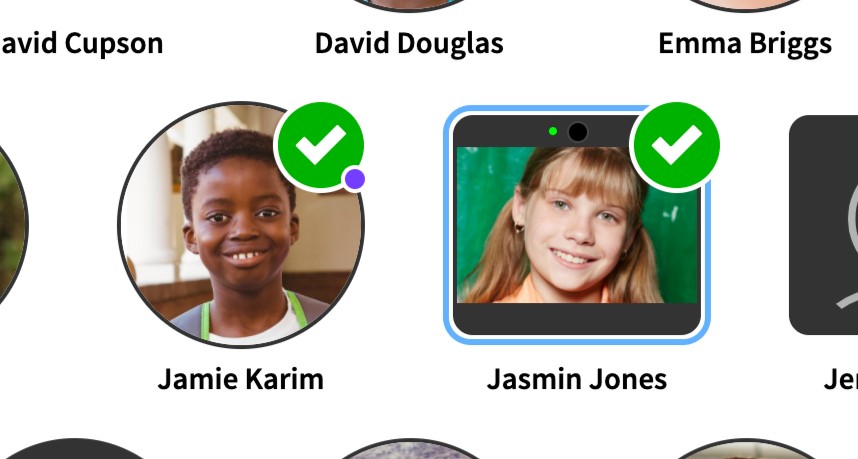
What happens to absence reports from parents?
Absence reports will automatically be entered as an
What about reporting?
The remote learner codes are supported in all existing attendance alerts. For example, you can receive a daily or
weekly breakdown of remote learners who didn’t attend, or who are a confirmed case of Covid-19 as required for
the
DfE’s educational setting status form.
The new codes require Studybugs Attendance. Register-taking for teachers requires Studybugs Registers.
As always,
How to Use Studybugs Registers Safely During Covid-19

When we first launched our groundbreaking supervised self-registration system, we weren’t anticipating a global pandemic. Thankfully, it’s really easy to comply with the government guidelines and make everyone feel safe and comfortable while using Studybugs Registers. It just takes a few small adjustments to the regular process.
Here are the two adapted approaches we’re seeing our schools take:
1. Children self-register with additional hygiene measures
Schools can still have children self-register and adhere to the guidelines. Younger children in particular are not necessarily expected to socially distance within their own bubble, but you can encourage children to use hand gel before tapping in and to keep their distance if they’re waiting to register.
2. Teachers tap in for children
If you’d rather avoid children touching the same surfaces, you could have staff register the children as they enter the classroom. This is still considerably quicker than calling out names the old way. You could even make a game of it — we’ve heard of teachers making it fun by asking children which part of their face they should tap to register them today... “today, I will touch your nose!”
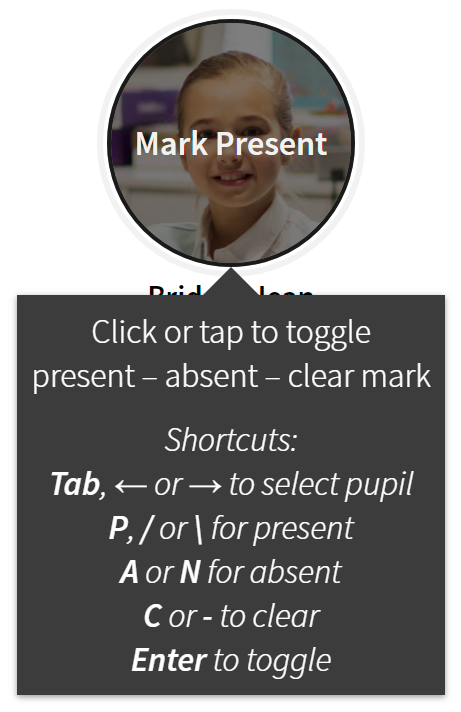
The approach you choose will, of course, depend on what’s right for your school and your pupils. It may even be that you take a different approach for different year groups, in line with their ability to maintain distance and avoid contact.
The choice is yours, but you certainly don’t need to let Covid-19 get in the way of more efficient registrations! In fact, increasing your learning time each day is doubly important now, given the interruptions to learning this year. It’s just one of the reasons hundreds of primary schools across the country use Studybugs Registers every day.
Covid-19 Tracking for Your School
Please sign in with your school, trust or local authority staff account to see this blog post.
Don’t have a staff account?
If your organisation is registered with Studybugs (or you’re not sure), please
Managing Bubble Registers
Please sign in with your school, trust or local authority staff account to see this blog post.
Don’t have a staff account?
If your organisation is registered with Studybugs (or you’re not sure), please
Managing attendance from 1 June
Please sign in with your school, trust or local authority staff account to see this blog post.
Don’t have a staff account?
If your organisation is registered with Studybugs (or you’re not sure), please
How Studybugs can help you reach parents during lockdown

We’ve noticed a lot of schools making good use of our free Messages add-on during the lockdown to reach pupils and parents, send work home and check up on children’s wellbeing.
We’re really pleased to see this, so to help all Studybugs schools stay connected to pupils and parents, we’ve put together our best tips to make the most of Studybugs Messages.
1. Use Studybugs to check on children’s wellbeing
Learning from home is going to be an unusual experience for all pupils. Whether you’re worried about vulnerable children or just want to check in with everyone, it’s easy to keep in touch with parents using Studybugs.
As long as a parent or carer has a Studybugs account or an email address in your MIS, you’ll be able to reach them via Studybugs. Parents will receive messages directly to their app or via email. You’ll also see read receipts, so you can be sure a parent has got your message.
2. Create bespoke messaging groups

We automatically pick up on classes and year groups from your MIS, but we can also set up specific groups to make it easy to get messages out to the right parents.
Many schools have created bespoke messaging groups such as “Key Worker Parents” or “Free School Meals”, so they can keep in touch with the families they need to most at this time.
There are two ways to create a bespoke group in Studybugs.
Option 1
You can create a custom group in your MIS with the parents you’d like to message. Let us know when you’ve done this and we’ll make it appear in Studybugs for you. It’ll then update automatically whenever you make any changes to the original group in your MIS.
Option 2
We can create a group for you. To do this, you’ll just need to send us over the list of names. You’ll then need to let us know about any future changes to the group, so we can update it.
3. Give teachers access to Messages
Many schools have chosen to give their teachers access to Messages so they can contact their classes directly.
It’s a straightforward and direct way for class teachers to check in with parents and pupils, send work out and
offer help for pupils who are learning at home.
4. Send work home as attachments
You can send work packs home as attachments or send out links to online lessons and learning tools. Messaging a specific class is easy — just type the class name into the “To” box.
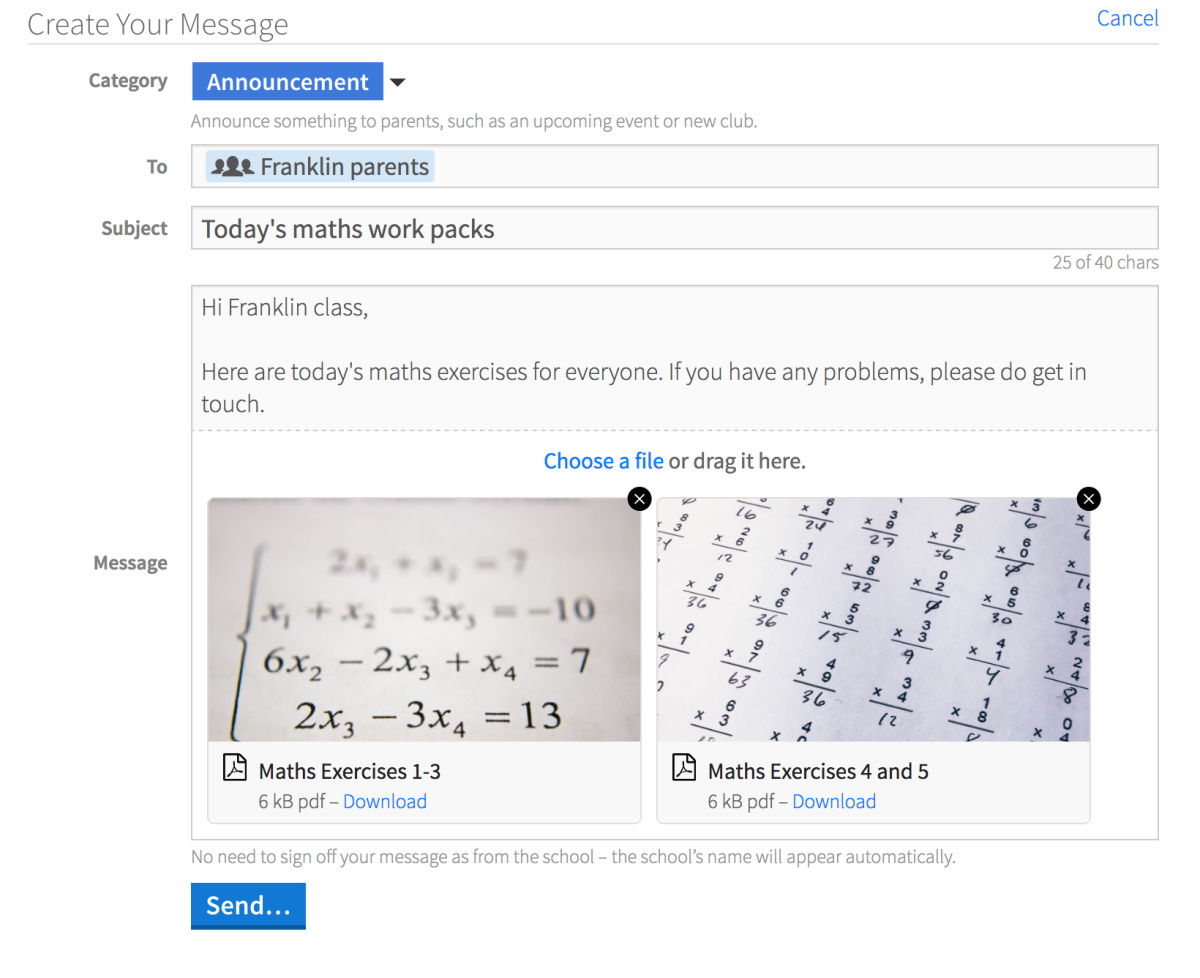
5. Contact us when you need help
As always, we’re available throughout the school day (and beyond!) to help you create messaging groups, set up
new staff members, and answer any questions you may have about using Studybugs.
When schools reopen, we’ll be ready for normal service to resume. But until then, it’s great to see so many schools using Studybugs Messages.
Don’t yet have a Studybugs school account?
If you’d like to start using Studybugs in your school to communicate with parents for free, register here.
— Lucas Abbott
Coronavirus Symptom-Tracking
In light of the Covid-19 pandemic, we would like to ask you to keep reporting your child’s symptoms via Studybugs, even through school closures.
In the Studybugs app, you just need to open the family menu (top-right), select a child, then report them as ill or fine.
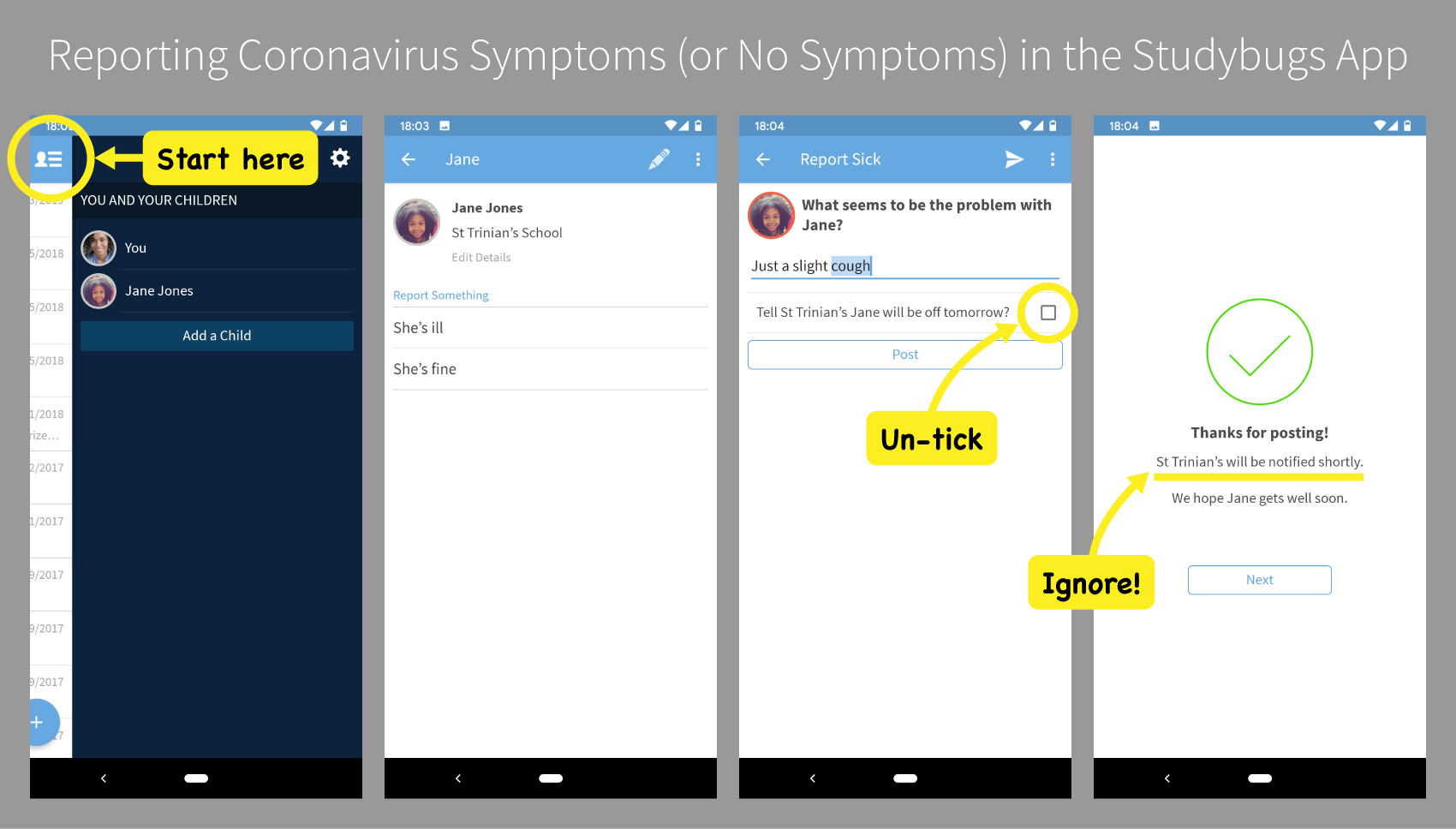

Make sure you untick the box if they’re not going to be absent from school. The message won’t go to your child’s school (please ignore if it says they’ll be notified – we’ll be removing this soon).
In the Studybugs website, just follow the prompts. Report now
What about the rest of my household?
You can post your own symptoms via Studybugs in the same way as for your child.
We don’t currently offer a way for you to report for anyone other than you and your children. Your partner, or any other adult member of your household, can register with Studybugs and report for themselves (but only one of you should add your children and report for them).
This is something we hope to streamline over the coming weeks.
What if we’re fine?
It’s really important for researchers to know this too – just as important as knowing your symptoms, in fact. If you or your child don’t have any symptoms, you can just say you’re fine.
How often should I report?
If you can report daily, that’s great. After your first report we’ll email you a daily reminder so you don’t need to remember (you can opt out of this if you like). If you miss a report or two though, not to worry – reports whenever you remember are very useful too.
Could you make it quicker to report each day?
We’re working hard to adapt and streamline Studybugs for coronavirus symptom-tracking, and lots of improvements are on the way. We’re also working with a team of epidemiologists to collect further data that will be useful to researchers. If you’re registered with Studybugs, we’ll keep you posted as we roll out updates over the comings days and weeks.
Meanwhile we very much welcome your
What’s this for?
All symptom information is first completely anonymised, before being made available to researchers (in various organisations including Public Health England) working on coronavirus. Amongst other things, it will help shed light on the effectiveness of school closures, and help inform the decision as to when schools should re-open.
The anonymised symptom information is also shown on our “What’s Going Around” map which you’ll see when you’re signed in to our website.
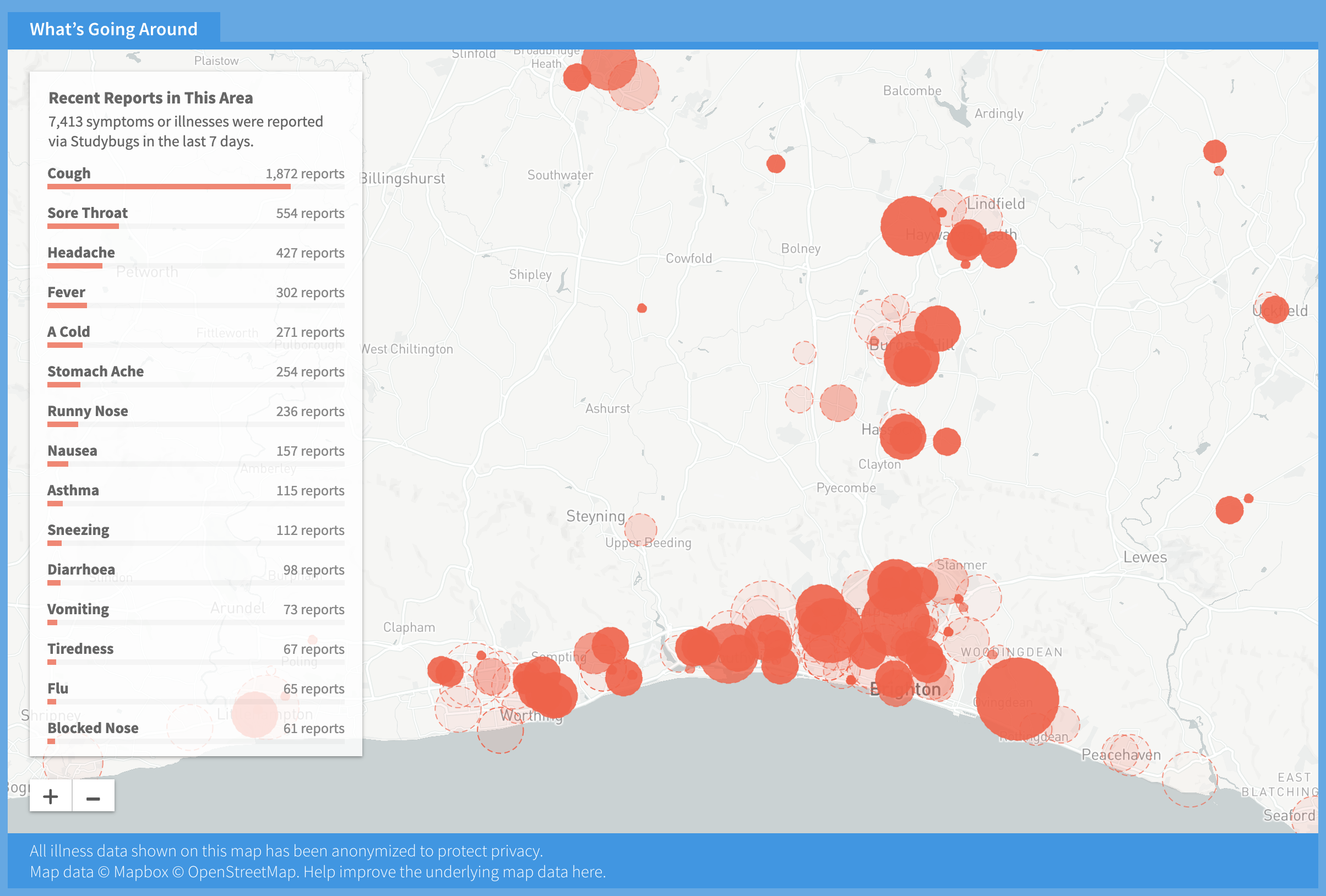

Why is Studybugs doing this?
Studybugs was started back in 2014 to track the spread of illness and help keep children healthy and in school. So this is what we do. We’re funded by government grants and by schools, and we don’t make any money from data (the anonymised data we collect is available free of charge under an open data licence) or have any plans to introduce advertising. The Studybugs platform is available free of charge to all, for ever.
We’re committed to ensuring the data we’re collecting, with your help, is put to good use and can make a positive difference in tackling the pandemic.
Thanks for your support.
— The Studybugs public health team
Opt in now for free early access to Studybugs Wellbeing
Please sign in with your school, trust or local authority staff account to see this blog post.
Don’t have a staff account?
If your organisation is registered with Studybugs (or you’re not sure), please
A Message About Messages
Please sign in with your school, trust or local authority staff account to see this blog post.
Don’t have a staff account?
If your organisation is registered with Studybugs (or you’re not sure), please
5 Things You Can Do With Studybugs Assistant
Please sign in with your school, trust or local authority staff account to see this blog post.
Don’t have a staff account?
If your organisation is registered with Studybugs (or you’re not sure), please
How Long Do You Spend Taking the Register?
When I was at school, we used to line up outside the classroom at 8.45am and wait for our teacher to let us in.
We’d then spend some time taking our seats and chatting, before our teacher would quieten us down to take the register. By the time that was done, it would be gone 9am and break time would already be less than an hour away.
It all seemed very normal to me, as I’m sure it would to many others. But when I started working for Studybugs, I realised just how much time it wasted every single day. How unnecessarily long the whole registration process used to be. Because I found out there’s a better way.
Get Kids to Register Themselves as They Enter the Classroom
You see, Studybugs has developed a very smart supervised self-registration service for schools. With Studybugs Registers, kids simply arrive, pop their coat on their peg, put their book bag away and tap the screen to mark themselves present.
What my teachers struggled to do in 15 minutes, schools can now do in under 4. With kids self-registering under supervision as they come in, you save all the time that was previously wasted waiting for kids to sit down, getting them settled, and calling out,
- “Jack.”
- “Here, sir.”
- “Jasmine… Jasmine? Has someone seen Jasmine today?”
No, sir. Jasmine isn’t in today. And in a Studybugs school, we’d know that already, because Jasmine’s parents would already have reported her absence using the Studybugs app.
But anyway, where was I going with this? Ah yes, saving time…
Gain 23 Minutes of Teaching Time Every Day
Imagine how quickly you could start the day if you didn’t have to take the register manually after the kids have come in. Imagine being able to start your day as soon as they’ve walked through the door. Oh, and if your pupils make lunch choices every morning, they can do that on the way into the classroom too.
When we first introduced Registers, we sat in and timed actual registration sessions in schools to see how effective it was. We found that, on average, teachers gained 23 minutes of teaching time every day. That’s an extra three weeks every year.
See How Much Time You Could Save When Taking Registers
But that’s enough from me. Try out our calculator to see for yourself how much time you could save by using Studybugs Registers.
Want to Find Out More?
We’d love to show you how it works in person.
— Lucas Abbott
A Busy Summer at Studybugs
Please sign in with your school, trust or local authority staff account to see this blog post.
Don’t have a staff account?
If your organisation is registered with Studybugs (or you’re not sure), please
4 Tips for a Happy, Healthy Start to the School Year

Whether they’re moving up a year or moving school altogether, it’s natural for kids – and parents! – to feel anxious about the change a new school year brings. But with a little organisation, you can help your child make their best possible start to the year.
Here are 4 tips to help your child with the change.
-
Plan ahead
A lot of the anxiety children feel about change comes from uncertainty. But you can help your child feel confident by talking things through with them ahead of time.
Set aside time in the evenings to talk through their timetable or look at new homework. Prepare uniforms, lunches, textbooks and PE kits the night before they’re needed to avoid any last-minute stresses. And if they’re moving school, you could also practice the new journey to school together.
-
Get into a routine
Getting into a routine is a great way to build healthy habits. It also helps your child feel like they have control over important parts of their day. So encourage your child to wake up with plenty of time before school. Try to eat together in the evenings and chat about their day. And set a reasonable bedtime, so your child can recharge for the next day.
-
Be positive
Your child could have lots of conflicting feelings about starting the new year. You can help put their mind at rest by being positive about the changes. If they’re nervous, you can also reassure them that lots of other children will feel the same way.
-
Don’t push too hard
Once school starts, simply be there to talk if they want to share. But it’s ok if they’re not ready straight away. Try to avoid asking if they’ve made friends yet, or if they’re settling in well, as it might make them feel like they’re taking longer than other people. Instead, ask what they did at lunchtime or what they learnt about in one of their lessons.
Of course, the most important thing is just to be there for your child any way you can. Some kids will find it easy, some a lot harder, but with time, we hope every child will come to really enjoy their time in school this year. So from everyone here at Studybugs, we wish you and your child a very happy, healthy new school year.
Does Your Child Suffer from Asthma?
If you use the Studybugs app and your child suffers from asthma, researchers at Brighton & Sussex Medical School (BSMS) and the Royal Alexandra Children’s Hospital need your help!
They’re conducting a study looking at innovative ways to improve management of childhood asthma, and are looking to recruit parents – and school staff – to take part.
Each year many children end up in hospital with acute asthma attacks and some of them will die of this each year. Most attacks are preventable with the right management. The Royal Alexandra Children’s Hospital is working closely with Studybugs and this study is part of a broader project called “Inspire” which you can read about here.
Participation involves a 30-minute interview (on the phone or in person) exploring use of the app for health management purposes.
The researchers are also interested in speaking with school staff who are familiar with the Studybugs system (but don’t necessarily have children with asthma).
If you’d be willing to take part, please let us know and we’ll put you in touch with the research team.
Keeping Children with Asthma Healthy and in School
What if there was a way to improve the health of children with asthma and reduce the number of days they have to miss of school? Well, the ‘Inspire’ project (everychildisdifferent.org/inspire), officially launched today, aims to do just that.
The project is a collaboration between the Brighton and Sussex Medical School (BSMS), the Royal Alexandra Children’s Hospital, Brighton & Hove City Council, public health specialists EpiConcept, and Studybugs.
The UK has among the highest prevalence rates of asthma symptoms in children worldwide, with on average three children with asthma in every classroom. Every year more than one in five children misses school due to asthma-like illness, and children with severe asthma may miss many weeks of vital education.
Professor Somnath Mukhopadhyay, leading the project for BSMS, said: “The connection between the health of children and school attainment is well documented. Not only are these children missing out on the quality of life they deserve, but their asthma has a real knock-on effect, impacting on their education, and possibly even their future careers.”
Inspire will involve collecting data on asthma-related illnesses via the Studybugs app, and delivering tailored advice to improve treatment. We’re currently working hard on various enhancements to the app to make this possible. Meanwhile we’re inviting schools who haven’t already done so to register for the free version of Studybugs and invite parents to download the free app.
Schools and parents already registered with Studybugs will automatically benefit from the project and don’t need to do anything extra to take part.

Studybugs in Brighton & Hove
The Director of Public Health, Dr Tom Scanlon, and his team at Brighton & Hove City Council have just published their annual report, which this year focuses on social media. It’s an enjoyable read/watch and we’d recommend it to anyone interested in public health.
We’re delighted to be part of the report – see below.
Building on our excellent take-up in Brighton & Hove, we’re now working with the City Council and other local public health organisations on some exciting developments in children’s health – watch this space!
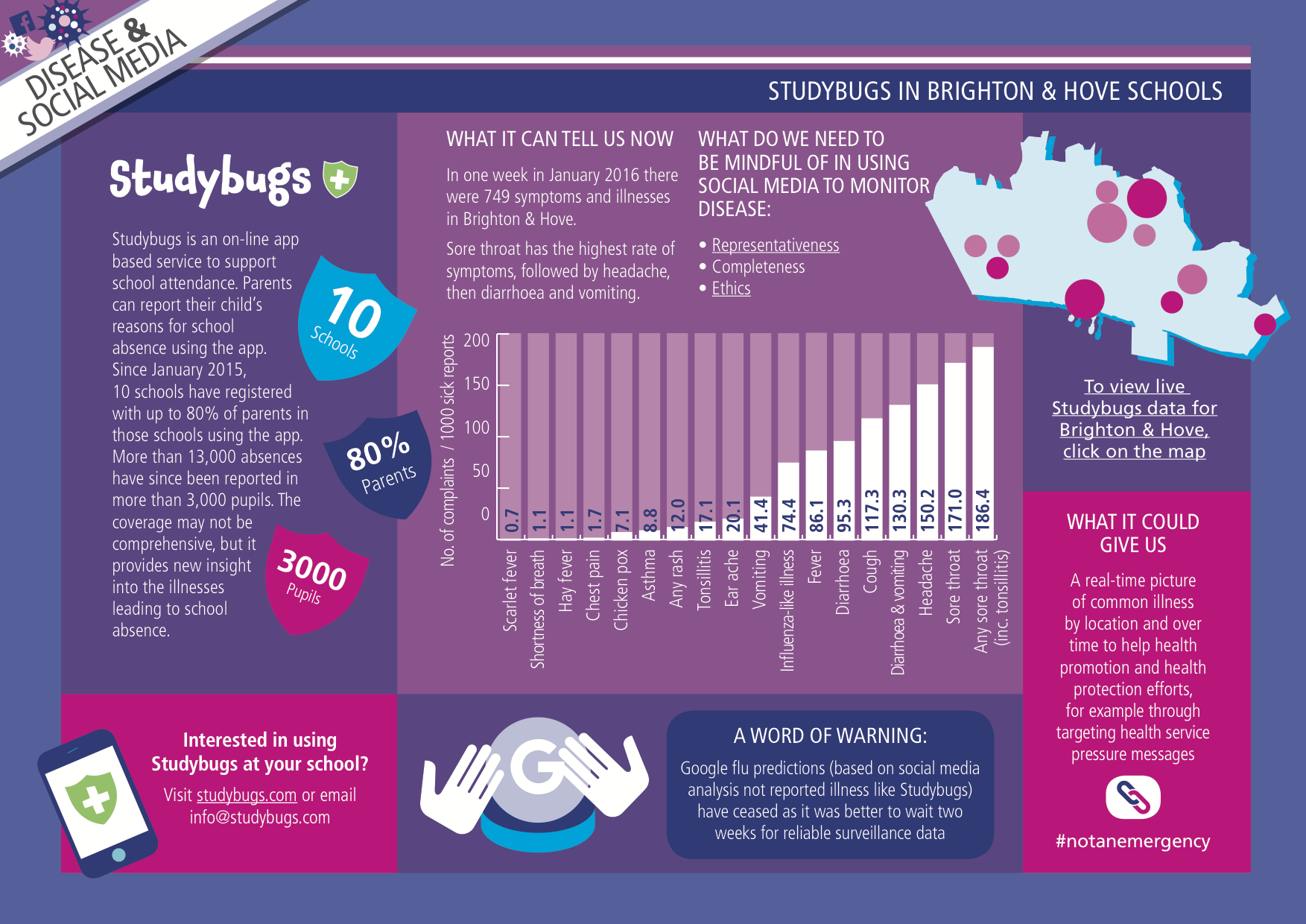
We are Studybugs
We’re excited to announce we now have a new name: we are Studybugs.
When we started out a couple of years ago, we set out to build a neat little social media tool for seeing what illnesses are going around, and the name ‘Sickly’ seemed to be suitably quirky. But since then we’ve grown into something much bigger, with a powerful online system now used by many thousands of people, that aims to improve children’s health and – ultimately – achievement at school.
We feel the name Studybugs fits much better with where we are now and where we’re heading. It reflects both the children – the “study bugs” (preferably studying hard rather than being sick!) – and our growing work in public health and the “study of bugs”. It’s appropriate, positive and distinctive, plus it leaves options open for future development of our apps and services.
We’re excited for what the future holds as we continue on our journey as Studybugs!
We hope you like the new name. If you’ve any comments, good or bad, please do send us a note at feedback@studybugs.com – we’d love to hear from you.
P.S. If you’re already a user of Sickly, there’s nothing you need to do. The old Sickly apps continue to work as before and links automatically redirect to our new website studybugs.com. Oh, and on the legal side of things, we’re the same company as before, just with a different name, so our commitments to our customers, users and partners haven’t changed.